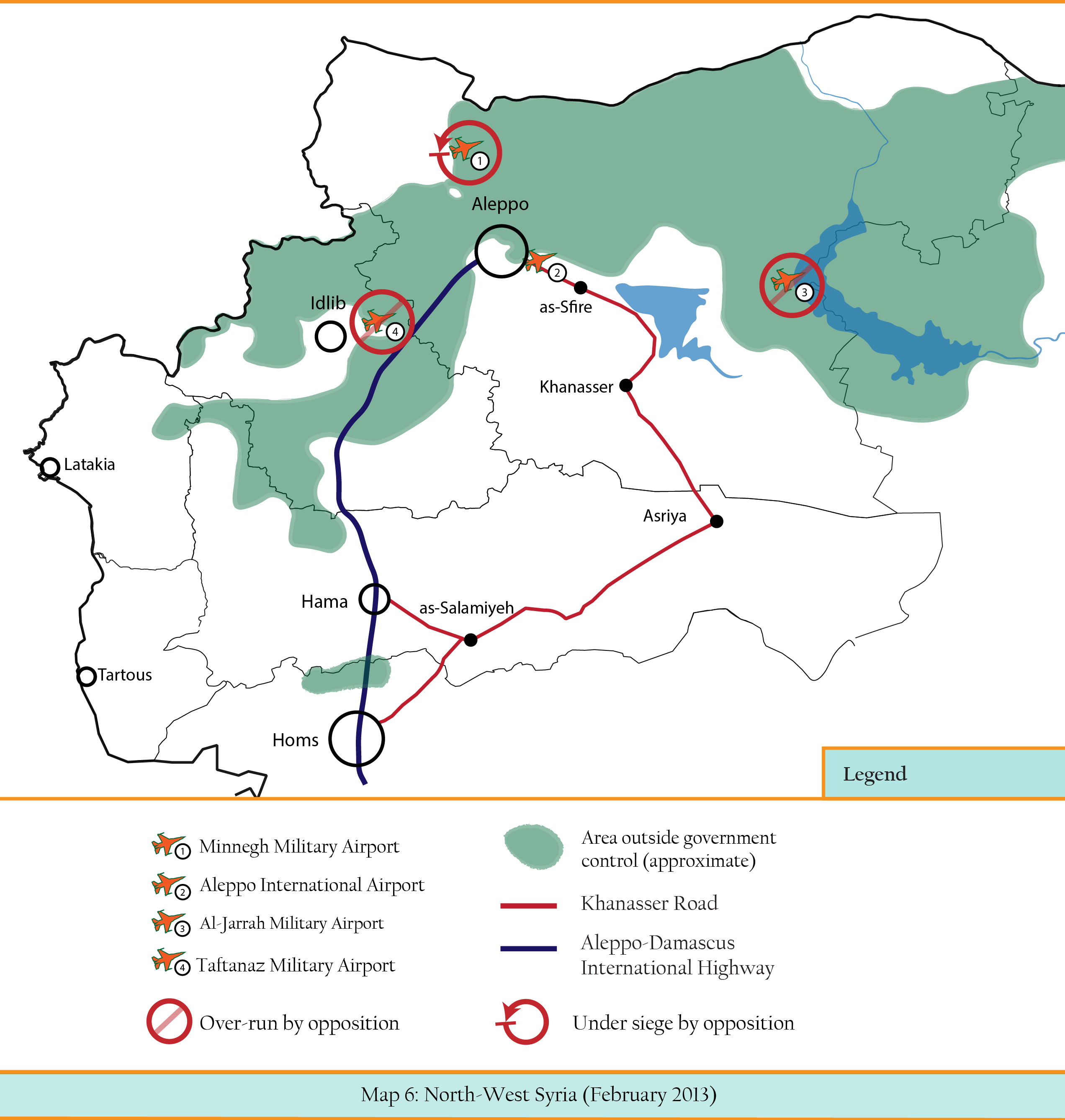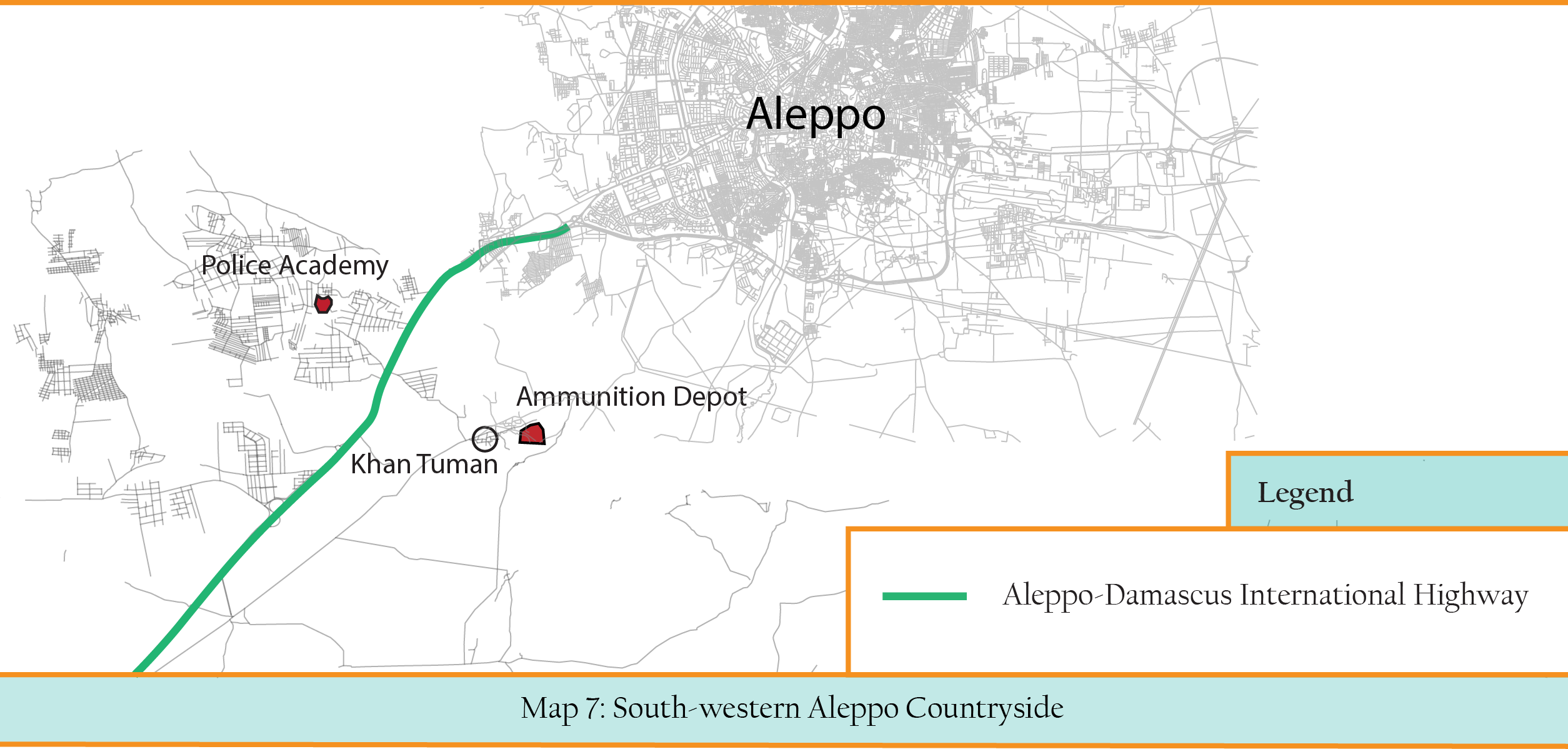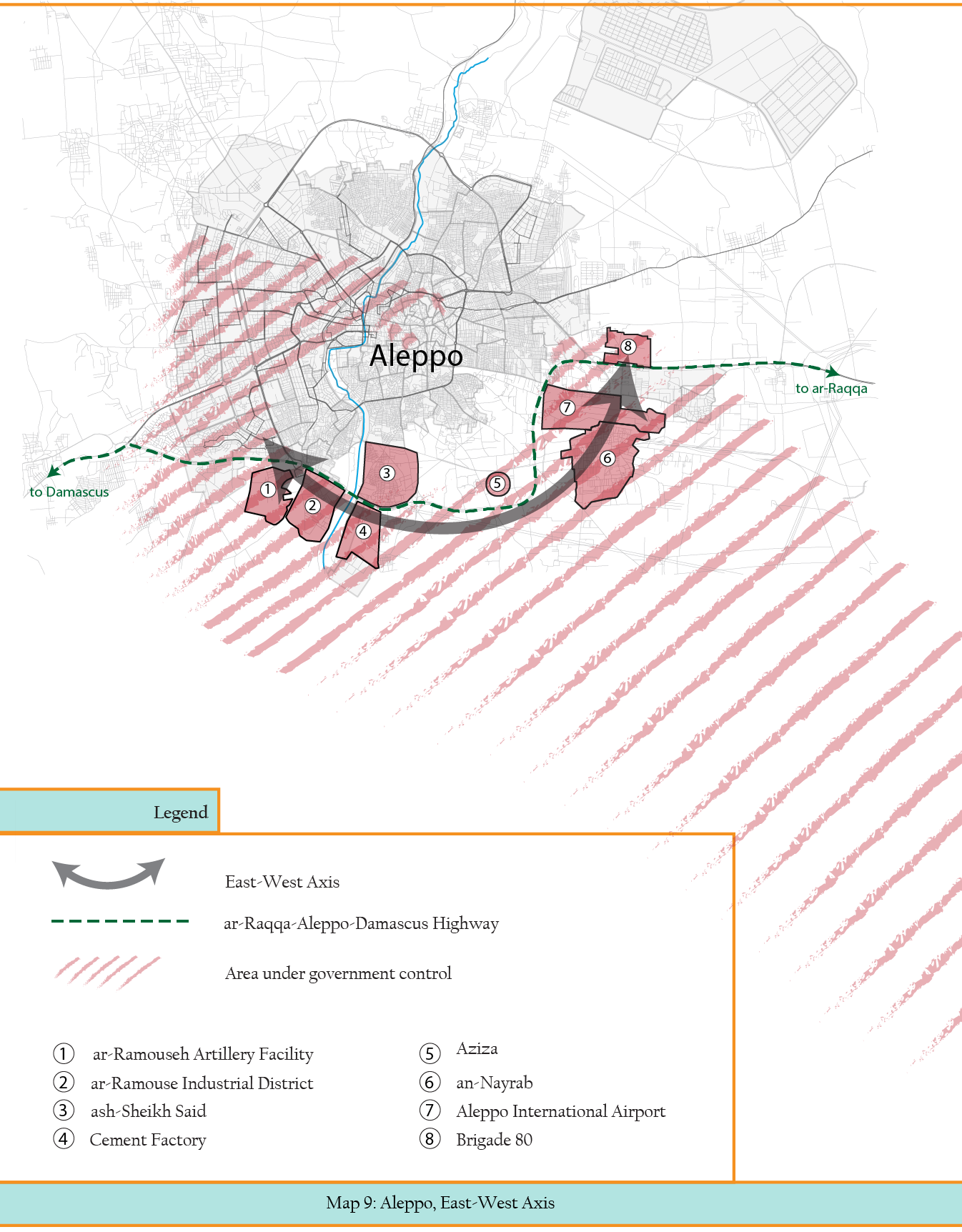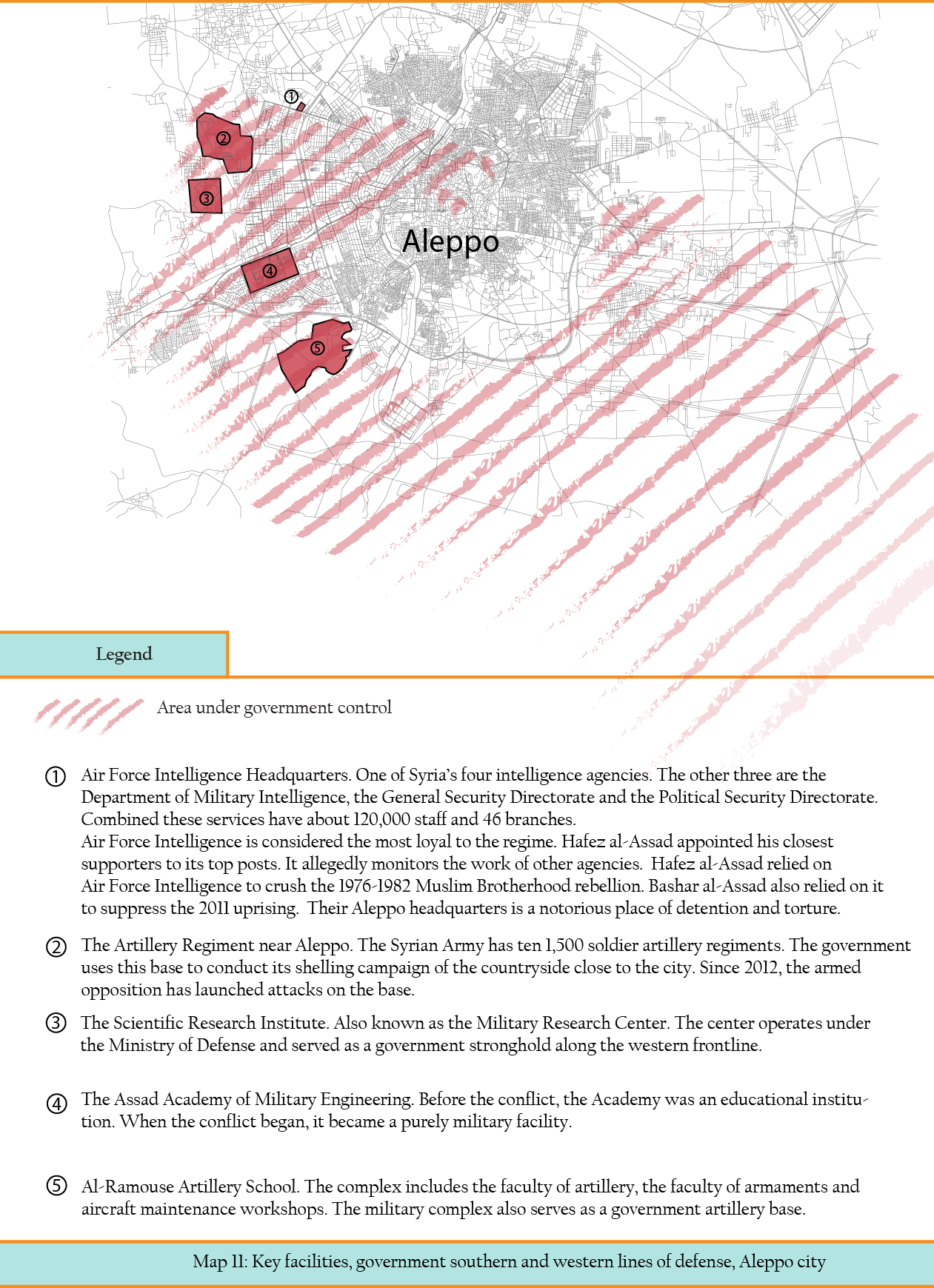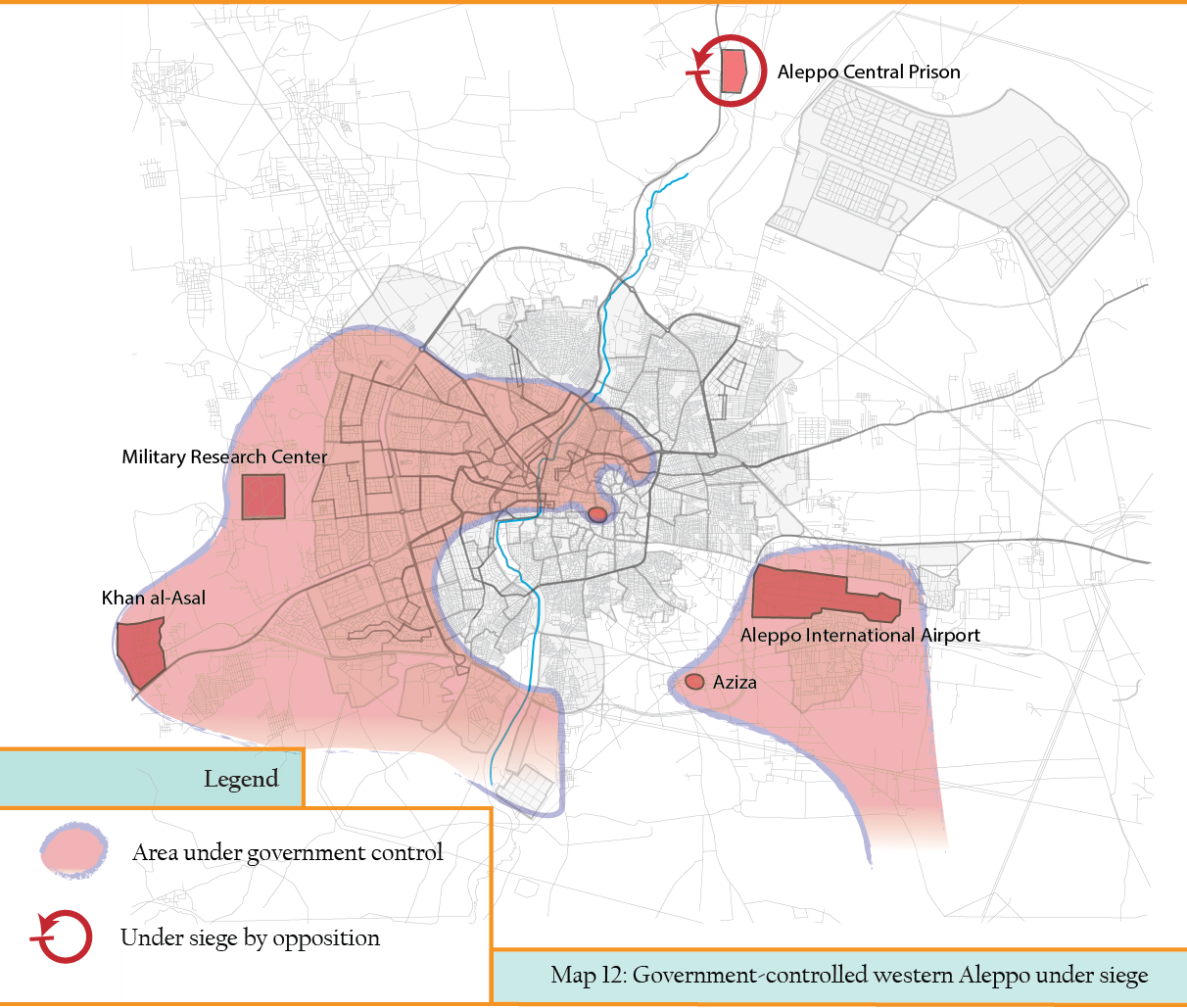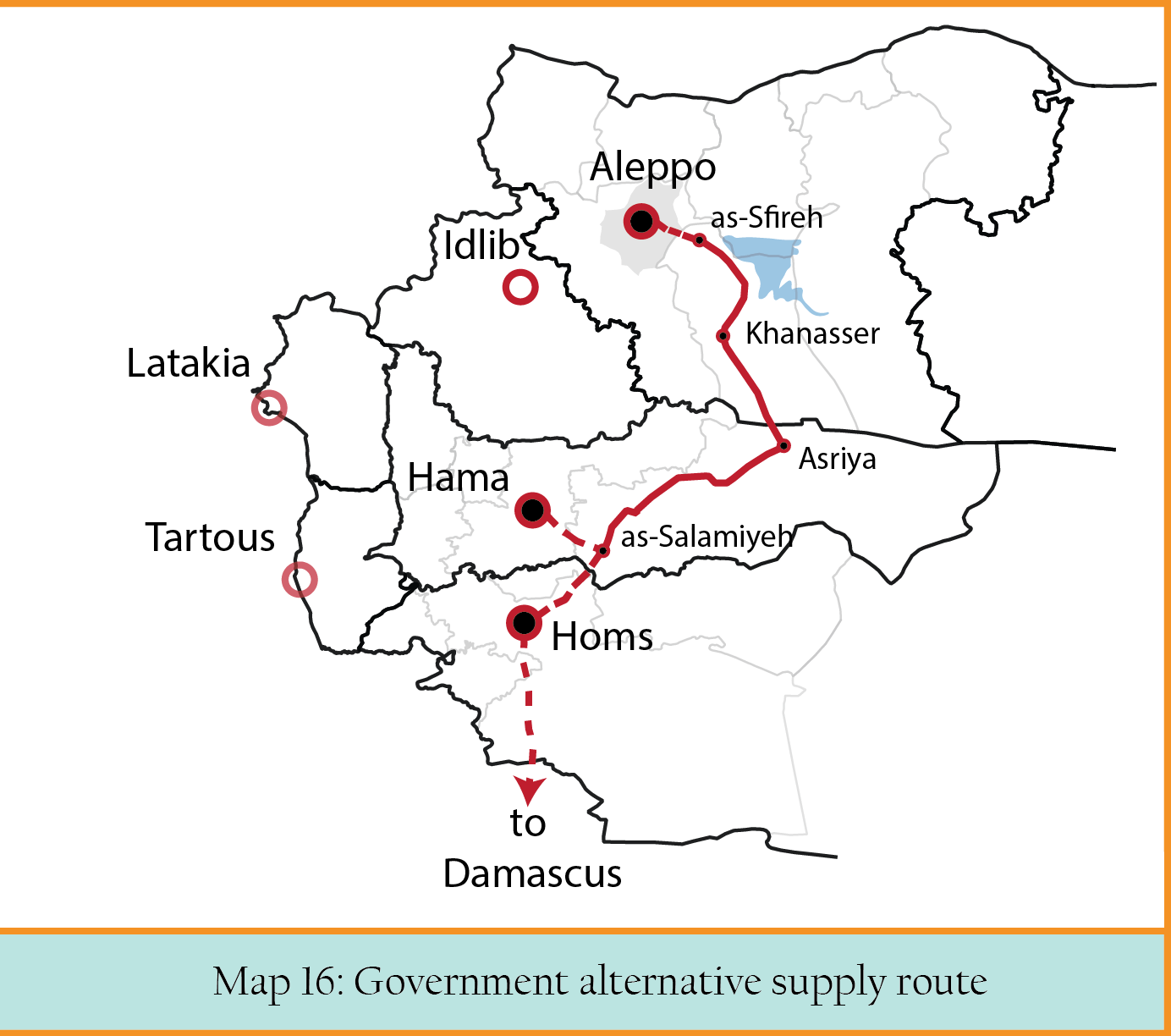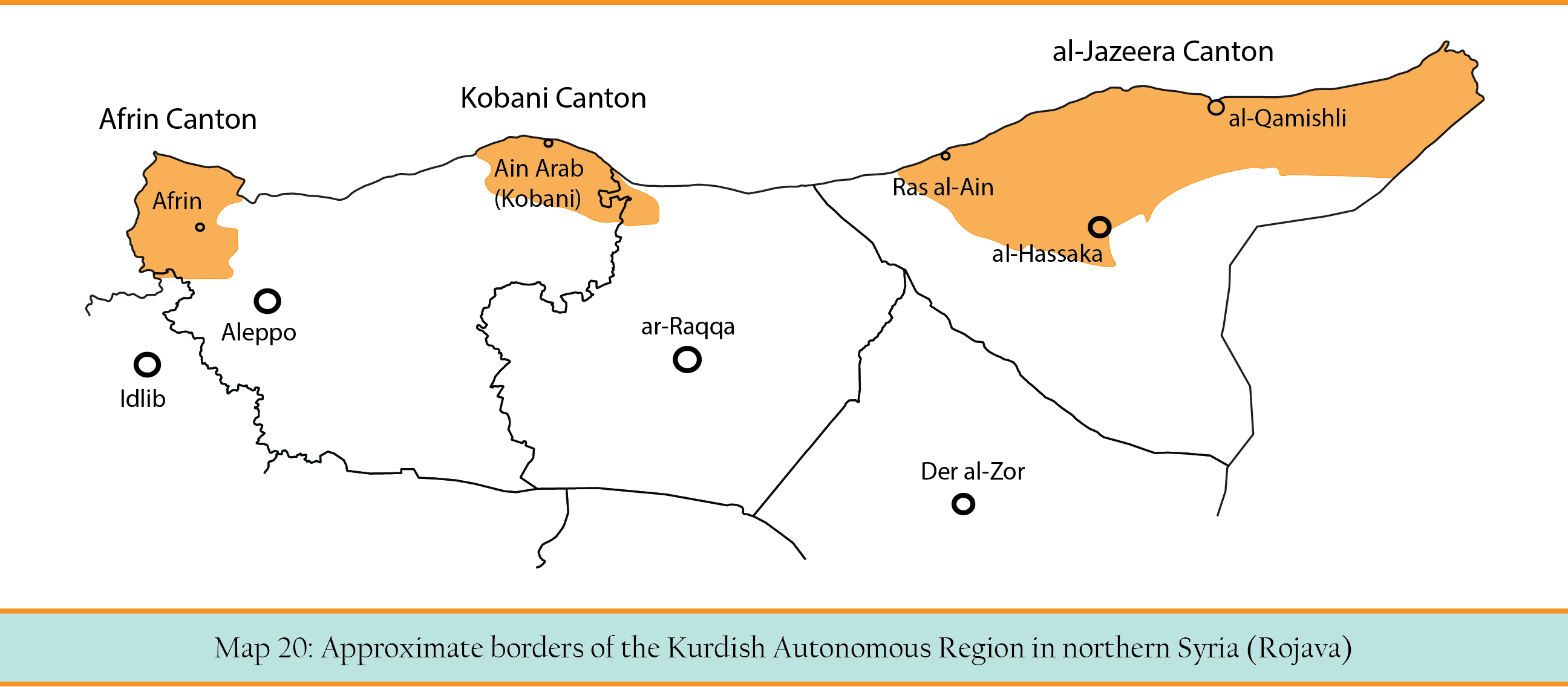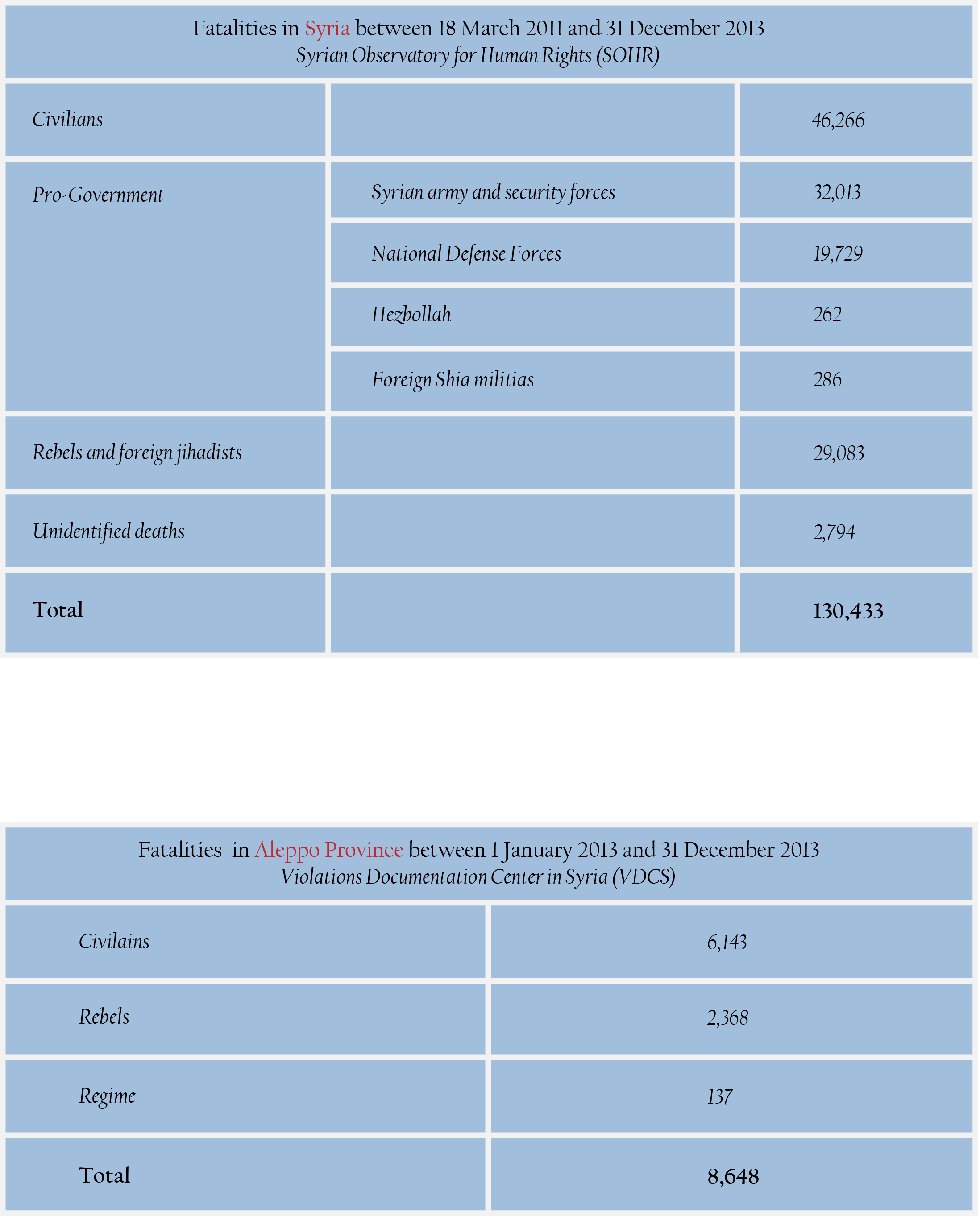Click here to download the PDF file
ENCIRCLING THE REGIME IN ALEPPO (JANUARY-MARCH)
With the creation of the Supreme Military Council (SMC), the rebel strategy shifted towards overrunning airports and military bases. It was now focused on expelling the regime from the Aleppo countryside, reducing its ability to supply its forces. Soon the regime would be left with only one supply route to the city.
On 7 January, General Salim Idriss said the SMC would first focus on overrunning airports to diminish the Syrian military’s air power and then move to artillery and missile bases. In the next two months, the rebels captured two airbases. Even though the SMC claimed to play a key role in these operations, Jabhet an-Nusra (JN) and Syrian Islamic Front member Ahrar ash-Sham were the leading fighters. Coordination among more radical groups such as JN and more moderate SMC-affiliated groups was noticeable and proved to be effective.
JN, the Syrian Islamic Front and the Syrian Liberation Front took control of the Taftanaz airbase near Idlib city, a key position overlooking the north-south highway, on January 11. Taftanaz was the largest airbase yet to come under rebel control. On 12 February, the government lost another airport near Assad Lake, east of Aleppo. The rebels also came close to the Aleppo International Airport after occupying large swathes of the nearby base, known as “Brigade 80,” established to protect the airport. (See Map 6)
By March, rebels had captured two military facilities on both sides of the Aleppo-Damascus highway on the outskirts of Aleppo: the Police Academy near Khan al-Asal and a military ammunition depot near Khan Touman town. (See Map 7) The International Highway between Aleppo and Hama was now in rebel hands. For military and humanitarian support, the government used an alternative route that connected the two cities. (See Map 8) Expectations rose that the city would soon fall to the rebels as the government was now almost entirely cut off.
000
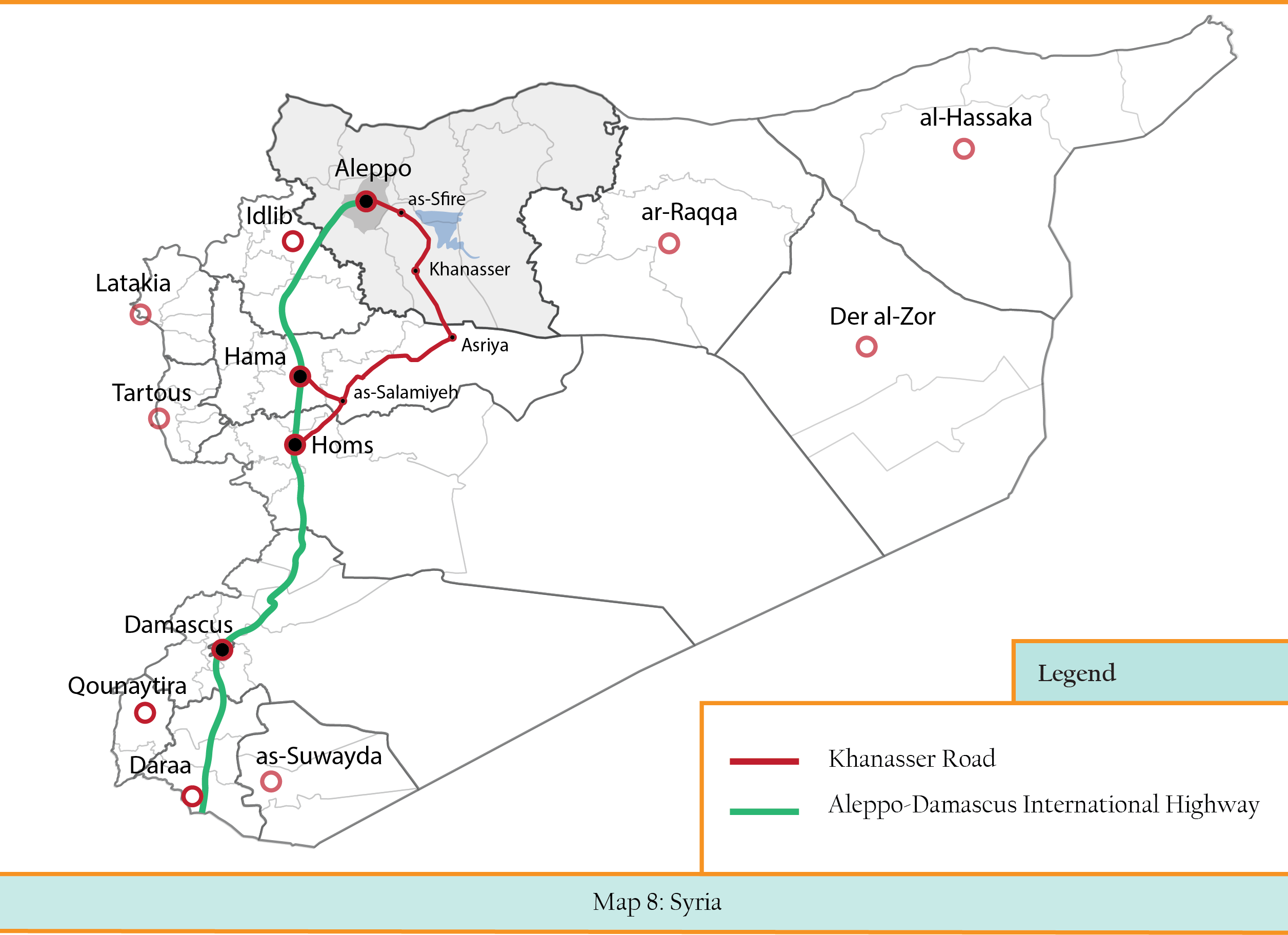 On March 19, chemical weapons were used in the government-controlled district of Khan al-Asal during military operations southwest of Aleppo city. Sixteen soldiers and 10 civilians died and 86 people were injured.[1] Both sides accused each other. Without a proper investigation, it was impossible to identify which side was responsible, but there is some evidence that the radical group JN may have been to blame. According to a Syrian military source, the group used an improvised rocket that contained a form of chlorine known as CL17 which is rated Level Two under the Chemical Weapons Convention, meaning that it has dual military and industrial uses.[2] All sides said they welcomed the UN Secretary General’s call for an independent investigation. In May 2013, the Independent International Commission of Inquiry on the Syrian Arab Republic, established in August 2011, began an investigation.
On March 19, chemical weapons were used in the government-controlled district of Khan al-Asal during military operations southwest of Aleppo city. Sixteen soldiers and 10 civilians died and 86 people were injured.[1] Both sides accused each other. Without a proper investigation, it was impossible to identify which side was responsible, but there is some evidence that the radical group JN may have been to blame. According to a Syrian military source, the group used an improvised rocket that contained a form of chlorine known as CL17 which is rated Level Two under the Chemical Weapons Convention, meaning that it has dual military and industrial uses.[2] All sides said they welcomed the UN Secretary General’s call for an independent investigation. In May 2013, the Independent International Commission of Inquiry on the Syrian Arab Republic, established in August 2011, began an investigation.
On 15 January, at least 80 students died in an explosion at Aleppo University as they were sitting for exams.[3] Again the sides traded accusations of blame, but witnesses said the weapon was a bomb dropped from a jet, meaning it must have come from the government side. At the end of January, the bodies of dozens of executed people were exposed when the Queiq River receded during the dry season. They were probably killed by government soldiers and the stream carried the bodies from government-held areas to the rebel-controlled district of Bustan al-Qaser.
By the start of 2013, the humanitarian situation had deteriorated in most of Aleppo province. While some border towns like Azaz had access to international aid, Aleppo city remained difficult to reach due to the lack of transport and the poor security situation. Regime-held areas received aid through the Syrian Arab Crescent but this was limited during periods of siege.[4]
Food prices surged. Across Aleppo Governorate, the price of bread was 40-50 per cent higher than other provinces.[5] In Aleppo city, the price of 1 kilo of bread, if it could be found, rose from 0.15 USD to 2.50 USD (150 Syrian pounds, SP). The price of a gas cylinder gradually increased from 300-600 SP (6-12 USD when approx. 45 SP equaled 1 USD) at the beginning of the conflict in Aleppo to 4,000 (67 USD) in December 2012.[6]
At the political level, Sheikh Muaz al-Khatib, the head of the National Coalition for Syrian Revolutionary and Opposition Forces (National Coalition), called for negotiations with regime representatives. This was part of an initiative to get Assad to release prisoners and negotiate a peaceful transfer of power in the region. Assad rejected the proposal.
BATTLE OF THE TWO AXES (APRIL)
After the rebels successfully reduced the government’s presence around Aleppo, they focused on southern areas that connected the city to other government-controlled areas. After successful offensives in the Aleppo countryside, the rebels concentrated on cutting the supply line connecting Aleppo to Hama.
Two interconnected axes were emerging. One connected the western part of the city, under government control, to the International Airport – the east-west axis. (See Map 9) This ran from the ar-Ramouseh Artillery faculty/base, through the cement factory in Sheikh Said district, the town of Aziza, an-Nayrab district, an-Nayrab airbase and ended at the Airport.
The second – the southern axis – connected the east-west axis with central parts of Syria. It ran north-south through the towns of Tal Shagheb, Tal Assan, Turkan, Tal Aran, Tal Hasel and, most importantly, as-Sfireh which is next to a huge army facility known as the “Defense Factories.” The government’s alternative supply route went through this axis starting from Aleppo through as-Sfireh, Khanasser, Asrya, as-Salamiyeh and reaching the International Highway that connects Homs with Damascus. (See Map 10)
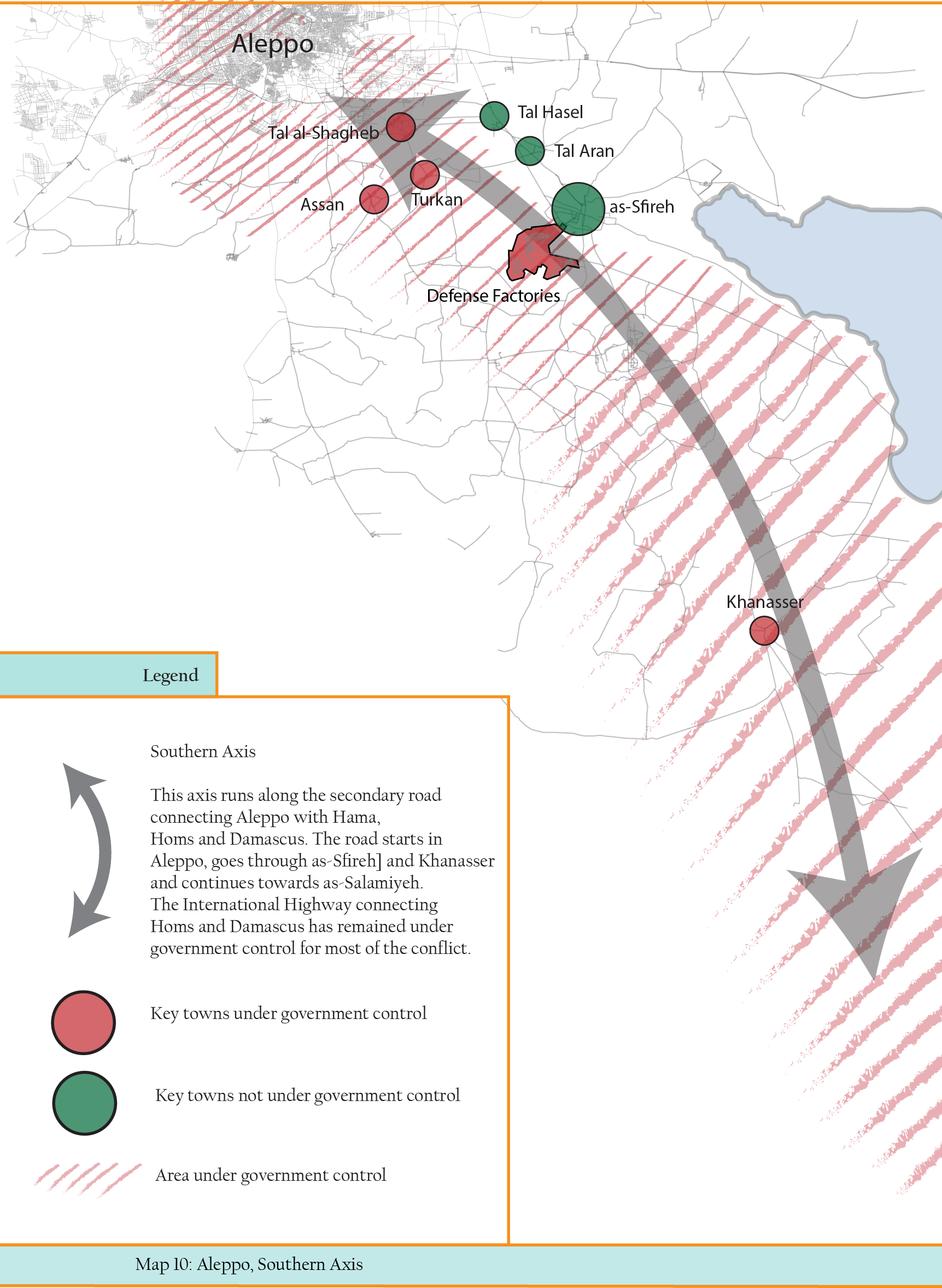 In early April, as-Sfireh came under rebel control. This increased pressure on the Defense Factories, where large quantities of arms, including heavy artillery and missiles, were stored. Rebels aimed to cut off regime supply lines to Aleppo.
In early April, as-Sfireh came under rebel control. This increased pressure on the Defense Factories, where large quantities of arms, including heavy artillery and missiles, were stored. Rebels aimed to cut off regime supply lines to Aleppo.
In the city, rebels and government forces agreed to a ceasefire on 16 April to collect decomposing bodies from the no-man’s land between their positions.[7] That day was one of the few when weapons were silent.
The Ancient City of Aleppo UNESCO World Heritage site fell victim to the ongoing violence. The Citadel was used as a sniper base by the government and was therefore targeted by rebels.[8] It is most likely that on 24 April, government forces shelled and destroyed the minaret of the Umayyad Mosque, built in 1090, as they believed rebels were positioned inside. This has been one of the most serious acts of destruction of heritage in the conflict.
On 10 April 2013, the leader of the Islamic State of Iraq (ISI), Abu Bakr al-Baghdadi, announced the merger of ISI and JN. The new group would be called the Islamic State in Iraq and ash-Sham (ISIS) and would be under his command.[9] The leader of JN, Abu Mohammed al-Golani, responded that he had not been consulted. He then revealed JN’s connection to al-Qaeda and referred to its leader, Ayman al-Zawahiri, for a ruling on the merger.[10] In a June letter, al-Zawahiri commanded the two organizations to operate separately: ISI in Iraq under Baghdadi’s leadership and an-Nusra in Syria under Golani’s leadership. Al-Baghdadi refused to accept the decision. (See Box Four)
BOX 4: Jabhet an-Nusra (JN) and the Islamic State in Iraq and ash-Sham (ISIS)
Jabhet an-Nusra (JN) was established in Syria with the help of al-Baghdadi’s Islamic State of Iraq (ISI) in late 2011. ISI provided experts, fighters and funding.[11] Before this mystery relationship was untangled, there were some indications that JN had connections to al-Qaeda affiliate groups in the region. U.S. intelligence suspected al-Qaeda involvement in Syria in February 2012.[12] The U.S. government listed JN as a terrorist organization on 11 December 2012.[13]
Throughout 2012, ISI built a strong network connecting western Iraq, where it had a significant presence, with eastern Syria. In July 2012, then Iraqi Foreign Minister Hushyar Zibari said that Iraq had solid evidence that ISI was crossing the border towards Syria.[14] These warnings did not attract much attention. Meanwhile, JN became one of the best-funded, equipped and capable groups. It also attracted the majority of foreign fighters in Syria. Between late 2011 and April 2013, ISI operated under JN’s flag and drew most of the foreign jihadis arriving in the country.
Despite al-Golani’s rejection of al-Baghdadi’s merger plan, the ISI leader went ahead and established the Islamic State of Iraq and ash-Sham (ISIS). This confronted the fighters with three choices: become part of ISIS, become part of JN, or join another radical group in Syria. Since JN was considered a Syrian organization, most local fighters joined JN. Al-Golani himself confirmed that after the split only about 30 per cent of his fighters were foreigners.[15] Many of the foreign fighters followed al-Baghdadi and joined ISIS. A small minority of fighters left both organizations and joined other groups such as Ahrar ash-Sham.[16]
A fundamental difference between JN and ISIS was that JN became a “Syrian project.” JN was partly the product of the Syrian revolution and had the clear intent to remove the government and replace it with a radical Islamic State. ISIS, on the contrary, was not the product of the revolution. It was a foreign organization aiming to become the locus of global jihad.
THE REGIME UNDER FULL BLOCKADE (MAY-JUNE)
During this period, the regime desperately tried to keep its last defense lines in the southwest of the city and its last supply route operational. It also tried to reestablish control in the northern Aleppo countryside by deploying new troops.
After occupying many regime strongholds in the Aleppo countryside, the rebels intensified their attacks on the last government lines around the city. In May and June, regime-held areas remained under almost a full blockade. In the east, the government struggled to keep the International Airport, which was the last defensive line before the city. On the western and southwestern fronts, the rebels were also approaching government positions. (See Map 11) These included major facilities such as the Air Force Intelligence Building, al-Zahra Artillery Base, the Military Research Center, the Al-Assad Military Academy and the Artillery Faculty in ar-Ramouseh.
The government had lost most of northern Syria since the early days of the conflict. In Aleppo province it had retained some enclaves, including the Minnegh airport, Nubbul and al-Zahra towns and the Aleppo Central Prison. All were tightly besieged by the rebels. In an attempt to regain ground, the government launched Operation Northern Storm in June. It deployed new troops, including Hezbollah fighters, to two towns and reinforced the Minnegh Airport to attempt to connect these islands with Aleppo city. This tactic had been used in Al-Qusayr, Homs province where the government opened supply routes between islands under its control and besieged the rebels.[17]
The most vital of these frontlines for the regime was the southern one, which it needed to control to keep the southern axis open. The regime held its ground in most of the key connecting villages on the Aleppo-Khanasser-as-Salamiyeh-Hama road, though the rebels often disrupted supply lines. This made it difficult for government forces to receive supplies and also affected civilians besieged in government-controlled areas. By cutting this route, the rebels would put Aleppo under a full blockade and enhance their chances of ending the regime’s control of the west of the city.
Early in May, the Swiss jurist Carla De Ponte, a member of the UN Human Rights Council Independent International Commission of Inquiry on the Syrian Arab Republic, said there was no evidence the government had used Sarin nerve gas in Khan al-Asal in March 2011. Rather, she pointed the finger at the “opposition, the rebels.” The Free Syrian Army’s (FSA) deputy commander rejected the results of the investigation.[18] This statement was controversial. The UN investigation team’s mandate was actually limited to determining whether chemical weapons were used, without deciding the responsible party, the investigation had not been completed, and blaming “the rebels” was very general and possibly referred to a wide spectrum of armed groups.[19] The same commission later released a report stating that the “perpetrators likely had access to the chemical weapons stockpile of the Syrian military.”[20]
The possibility of JN’s involvement should be considered. Several incidents after the Khan al-Asal attack indicate that JN might have possessed Sarin. For instance, in late May, seven JN members were detained in the Turkish city of Adana with chemical materials that could be used to make Sarin.[21] Another potential source of the poison might have been the SYSACOO chemical factory, east of Aleppo, which came under JN’s control in December 2012.[22]
Life became increasingly difficult in Aleppo. The frontline between the two sides of Aleppo was perforated by passages – ma’aber in Arabic – which were the only way people survived. Civilians used these passages to move between rebel and regime areas to buy food or go to work. Hundreds of people died from sniper fire at the crossings and transporting goods became increasingly difficult.
By mid-May, the Syrian Observatory for Human Rights (Syrian Observatory) had documented about 82,000 deaths nationwide. The organization estimated that the real number could be as high as 120,000. Of the 82,000, 12,916 were “anti-Assad fighters” and 1,924 were army deserters. The regime’s military casualties were higher: 16,729 regular troops and about 12,000 militiamen. In addition, about 12,500 people were missing, mostly detained by the regime. The fate of 2,500 loyalist fighters captured by the rebels was also unknown.[23] According to the Violations Documentation Center of Syria, 11,039 people died in Aleppo province for reasons related to the conflict between March 2011 and May 2013.[24]
THE END OF THE REGIME IN ALEPPO? (JULY-AUGUST)
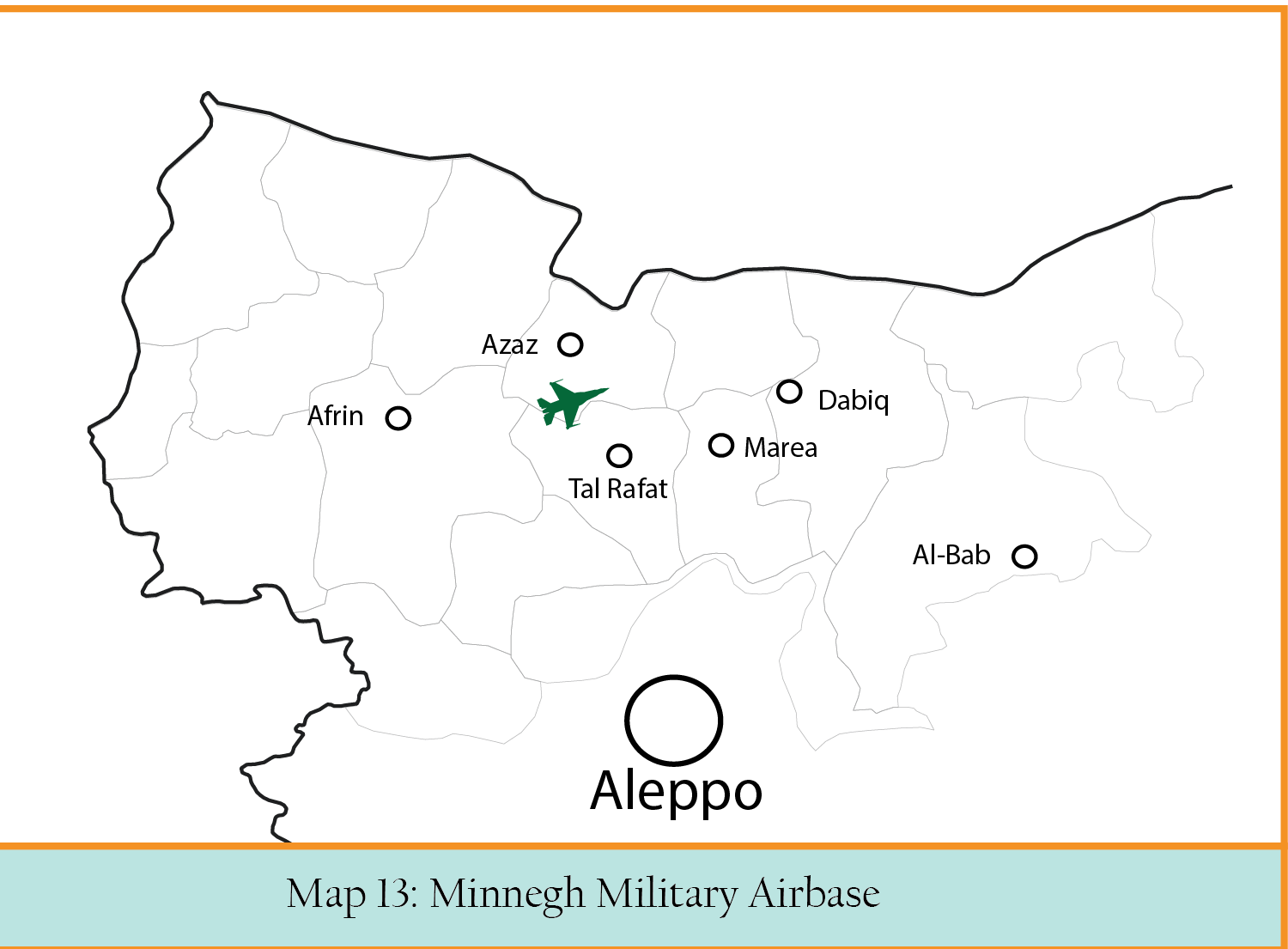 The government’s plan to re-establish control in the north of Aleppo province suffered a major setback when it lost Minnegh Airport. After the opposition took control of Khan al-Asal, cutting the last government supply line, the regime’s position seemed hopeless. Aleppo was expected to fall to the opposition.
The government’s plan to re-establish control in the north of Aleppo province suffered a major setback when it lost Minnegh Airport. After the opposition took control of Khan al-Asal, cutting the last government supply line, the regime’s position seemed hopeless. Aleppo was expected to fall to the opposition.
Operation Northern Storm failed because the government lacked sufficient forces. They lacked enough troops to take on JN, Ahrar ash-Sham, and ISIS which were well-funded, had well-established supply lines to Turkey and a strong motivating ideology. The government had lost Minnegh Airbase by 8 August. (See Map 13)
After a year of attacks, the opposition took Minnegh with the loss of 100 government soldiers. Many others were taken prisoner.[25] The final assault resulted from an alliance among several ideologically diverse groups. Asifet ash-Shamal, an independent, self-funded, exclusively Syrian group based in Azaz had a good relationship with SMC.[26] They fought alongside JN and Jaish Muhajireen Wa al-Ansar – a jihadi group led by a Georgian national who went by the nom de guerre Abu Omar ash-Shishani and eventually became ISIS’s leader in northern Syria.[27] In fact, the participation of the two jihadi groups was key to its success. In this way, the government lost yet another important military base, degrading its air capacity in the region.
On the western front, the government lost the Khan al-Asal district on 24 July, allowing the rebels to come closer to the city.[28] After the capture, JN summarily executed about 50 government fighters in contravention of international humanitarian law.[29] The opposition and the international community strongly condemned these executions.
In July and August, several opposition groups tried to cut regime supply lines along this axis. On 23 July, JN warned civilians against taking the as-Salamiyeh-Khanasser road for their own safety. Ahrar ash-Sham and Liwa al-Tawhid successfully cut the supply line.[30] These two groups now controlled key points on both the Aleppo-Damascus and alternative routes, putting government areas in Aleppo under a full blockade. (See Map 14)
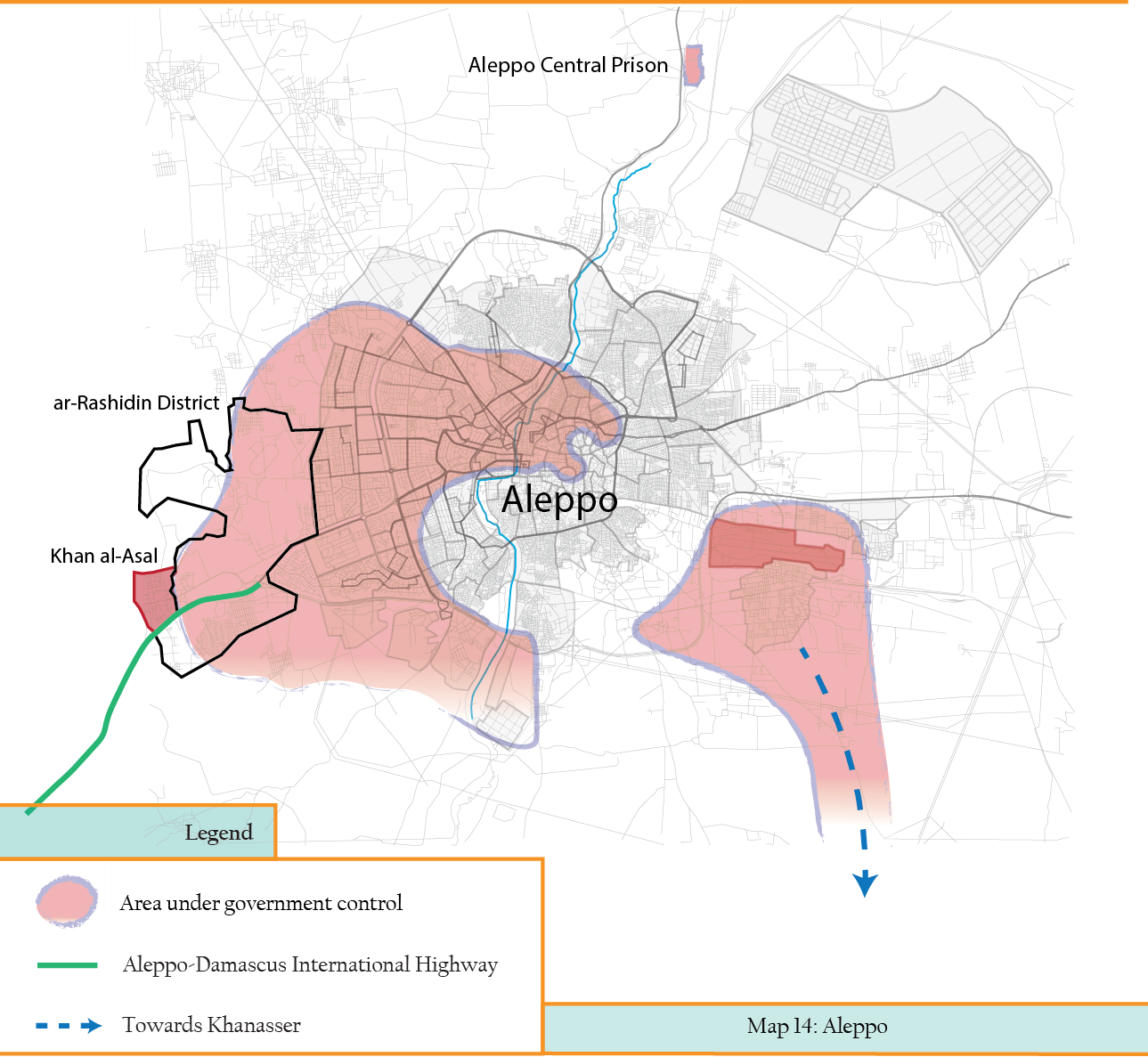 Fighting in Khan al-Asal closed the International Highway.[31] With the rebel takeover of Khanasser, government areas in the city were blockaded. By 9 July, it was difficult, if not impossible, to find fresh food in western Aleppo. The only way to get supplies widely available in rebel areas into government-controlled Aleppo was through the Karaj al-Hajez crossing in Bustan al-Qaser district. It became known as “The Death Crossing.”
Fighting in Khan al-Asal closed the International Highway.[31] With the rebel takeover of Khanasser, government areas in the city were blockaded. By 9 July, it was difficult, if not impossible, to find fresh food in western Aleppo. The only way to get supplies widely available in rebel areas into government-controlled Aleppo was through the Karaj al-Hajez crossing in Bustan al-Qaser district. It became known as “The Death Crossing.”
At first, the rebels forbade civilians from transporting food. This, however, created tensions between the armed groups and residents of rebel-held areas. The Islamic Court in rebel-held Aleppo city revised the decision and allowed residents to transport a few kilos of food each time they crossed.[32]
Rebels, government soldiers and snipers intimidated people crossing the frontline and killed many. As a well-known Aleppian writer put it, “A salad in Aleppo could cost you your life” referring to an incident where a regime sniper killed an old woman carrying vegetables from a rebel area to western Aleppo.[33] Prices skyrocketed. The cost of subsidized bread in regime areas increased fivefold and required standing in line for hours. Bread from private bakers rose from 20-25 SP to up to 200 SP for 750 g-1kg,[34] well beyond the reach of most people.
ISIS SAVES THE REGIME (SEPTEMBER-OCTOBER)
The government’s position in the north seemed hopeless. They were suffering losses on all fronts and making no gains. However, the city remained extremely important symbolically for the regime. In late September, they launched a major offensive from Hama towards Aleppo on the secondary route. This operation came when the rebels were preparing for their final offensive on the southern villages of Aleppo. Ahrar ash-Sham’s map (Map 15), explained the plan.[35]
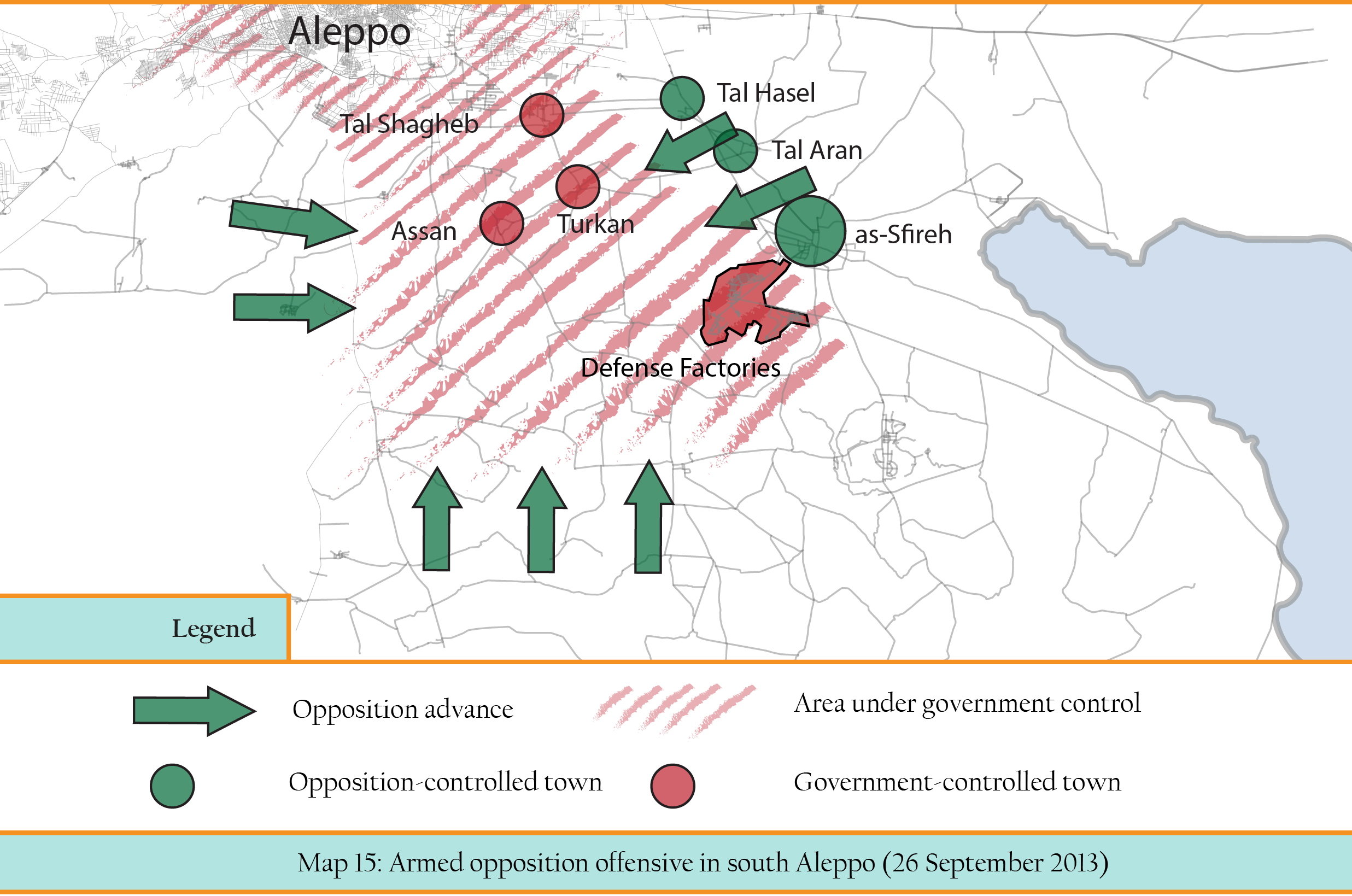 Source: Based on a map circulated by Ahrar ash-Sham
Source: Based on a map circulated by Ahrar ash-Sham
In late September, a military convoy of about 100 vehicles from the National Defense Forces (NDF), Hezbollah and Iraqi militias, left Hama to reopen the alternative route to Aleppo.[36] By the end of October, they had reestablished control over the Hama-Khanasser[37] and Khanasser-as-Sfireh roads.[38] In early October, the regime besieged the opposition stronghold of as-Sfireh and bombarded the town for three weeks. On 31 October, it entered the city.[39] Several opposition groups and ISIS had established the as-Sfireh operation room,[1] including the Aleppo Military Council (AMC), Ahrar ash-Sham, Liwa al-Tawhid, JN and ISIS. According to the SMC’s senior figure in Aleppo, Colonel al-Oqaidi, the city fell because of rebel disagreements.[40]
The regime’s success in Aleppo from September until December mostly resulted from poor rebel organization and a lack of coordination among groups, as al-Oqaidi complained. The rise of ISIS as a new actor with its own agenda also changed the dynamic. Before their split with JN in April 2013, ISIS had not attacked any groups affiliated with the SMC. After the break up, ISIS became increasingly hostile towards some rebel groups. Several incidents through July, August and September led to an all-out war between rebel groups and ISIS in Aleppo province.
In early July, ISIS killed several rebels who claimed to be part of the FSA.[41] On 11 July, an SMC leader was shot dead at an ISIS checkpoint in Latakia province.[42] A week later, the head of the SMC, Brigadier General Salim Idriss described ISIS as criminals and said he wanted foreign fighters out of Syria.[43] Separate incidents and clashes between ISIS members and FSA affiliates also took place in Jarablus, which later came under ISIS control.[44] In addition, civilians in Mnbej and al-Bab protested ISIS activities and a reported presence in these two areas.[45] Early in September, an FSA affiliate announced that ISIS had kidnapped nine of its leaders when in ar-Raqqa investigating another ISIS abduction.[46] As tensions rose, ISIS issued a statement announcing a military campaign against “the Free Syrian Army in eastern Aleppo.”[47] By then, ISIS had established itself as a dominant force in the region. (See Map 17)
A week after this open call for war, ISIS took over Azaz after series of skirmishes with the Asifet ash-Shamal brigade. ISIS also took control of the Bab as-Salam border crossing to Turkey.[48] The ISIS takeover of Azaz forced Liwa al-Tawhid, the largest armed group in Aleppo province, to intervene and mediate. Tensions remained high. ISIS announced it was now active in Aleppo city itself.[49] Between September and November, the organization expanded its control in the east of the city, setting up numerous checkpoints. [50]
This belligerence by ISIS came just before the Syrian Army launched the operation to retake the Khanasser road. [51] This led to speculation that ISIS and the government were cooperating against the opposition, in large part because ISIS mostly targeted opposition rather than government forces starting in June 2013.
While there is no solid evidence that the government and ISIS coordinated their fighting in Aleppo, it does appear the two did have a relationship. Realities on the ground often dictated the nature of relationships at any given time between armed actors. In this particular case, presumably, ISIS was threatened by the increasing influence of the armed opposition in Aleppo province and attacked their positions while they were busy confronting the regime. At the same time, the regime may have exploited increasing tensions between ISIS and the armed opposition. This should not be understood as a formal alliance between the regime and ISIS, but the reality of a war in which every side did whatever it takes to survive.
Aleppo city has been both a major source of and destination for displaced people. As of March 2013, slightly more than one million Aleppians had left over 50 neighborhoods in the eastern, rebel-held areas, mostly to escape barrel bombings and shelling.[52] At the same time, these neighborhoods hosted around 512,000 internally displaced persons (IDPs) who were mostly living with relatives.[53] As of September 2014, there were 49 functioning settlements for IDPs in northwest Syria, one under construction and 13 other possible settlements. In addition, there were 10 constructed, two under construction and 22 possible IDP settlements in the north of Aleppo, close to the Turkish border.[54]
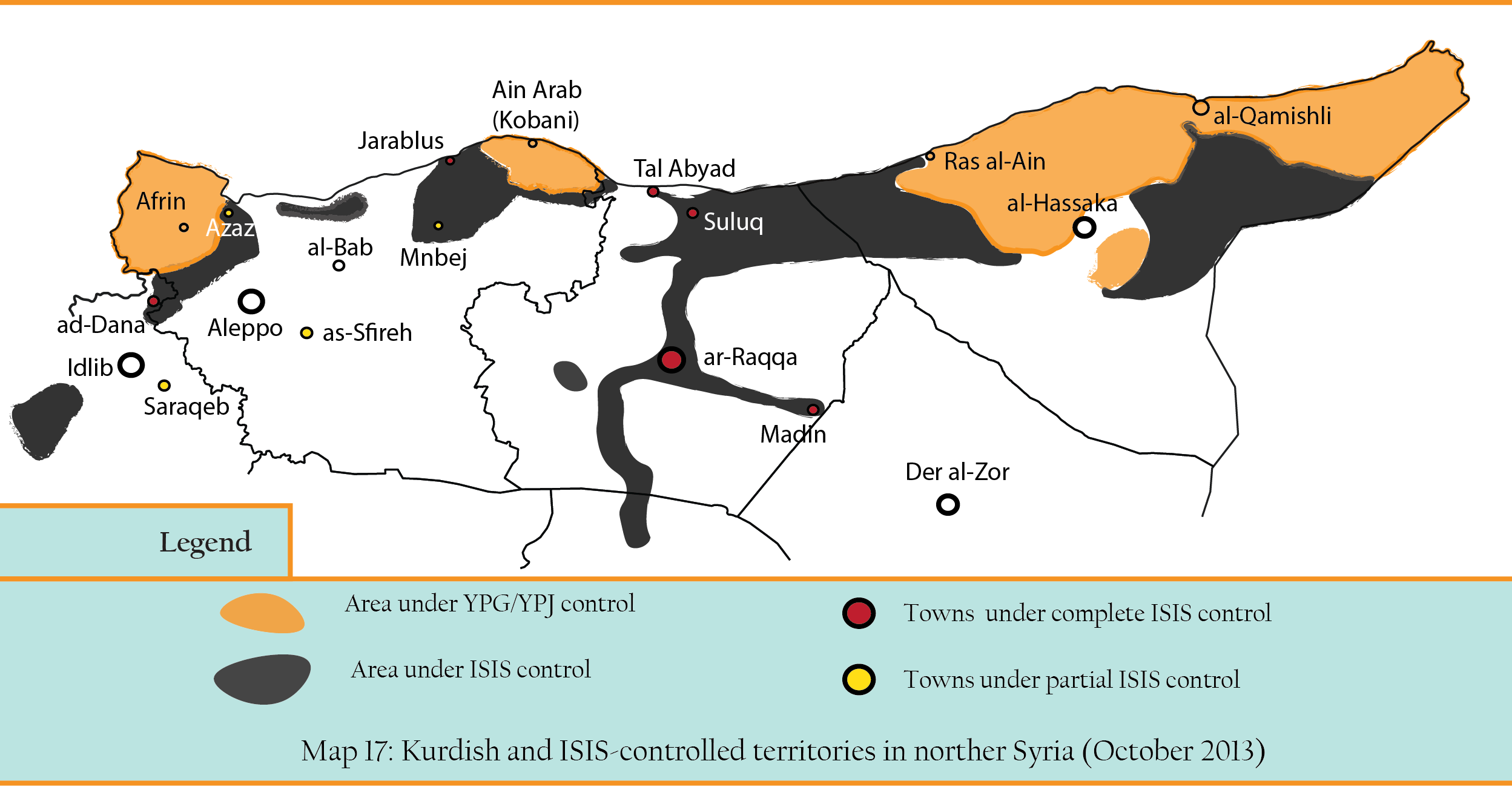 Source: Noria Research
Source: Noria Research
THE REGIME RETAKES THE INITIATIVE (NOVEMBER-DECEMBER)
After the fall of as-Sfireh, the government opened two new fronts: north of as-Sfireh towards the International Airport and around Brigade 80 and adjacent areas. On 3 November, al-Aziziyeh, next to as-Sfireh fell to the government.[55] The next target was Tal-Aran. The government devastated the town with barrel bombs before launching a ground offensive. Opposition defenses crumbled on 10 November and the government moved on to retake the next town along the road, Tal Hasel.[56] On the same day, the government said that the Brigade 80 base was again under its control, but fighting continued in the area.[57]
Rebel groups including Ahrar ash-Sham, Liwa al-Tawhid, JN and Islamic Kataeb Nour ad-Din Al Zanki signed a statement urging all opposition groups to repel the government.[58] ISIS also released a statement calling on Muslims to join the fight against the government.[59] Both rebel groups and ISIS managed to halt the regime’s advances until January.[60] The government’s most significant gain was to secure the supply line between the Defense Factories and the International Airport by mid-November 2013. (See Map 18)
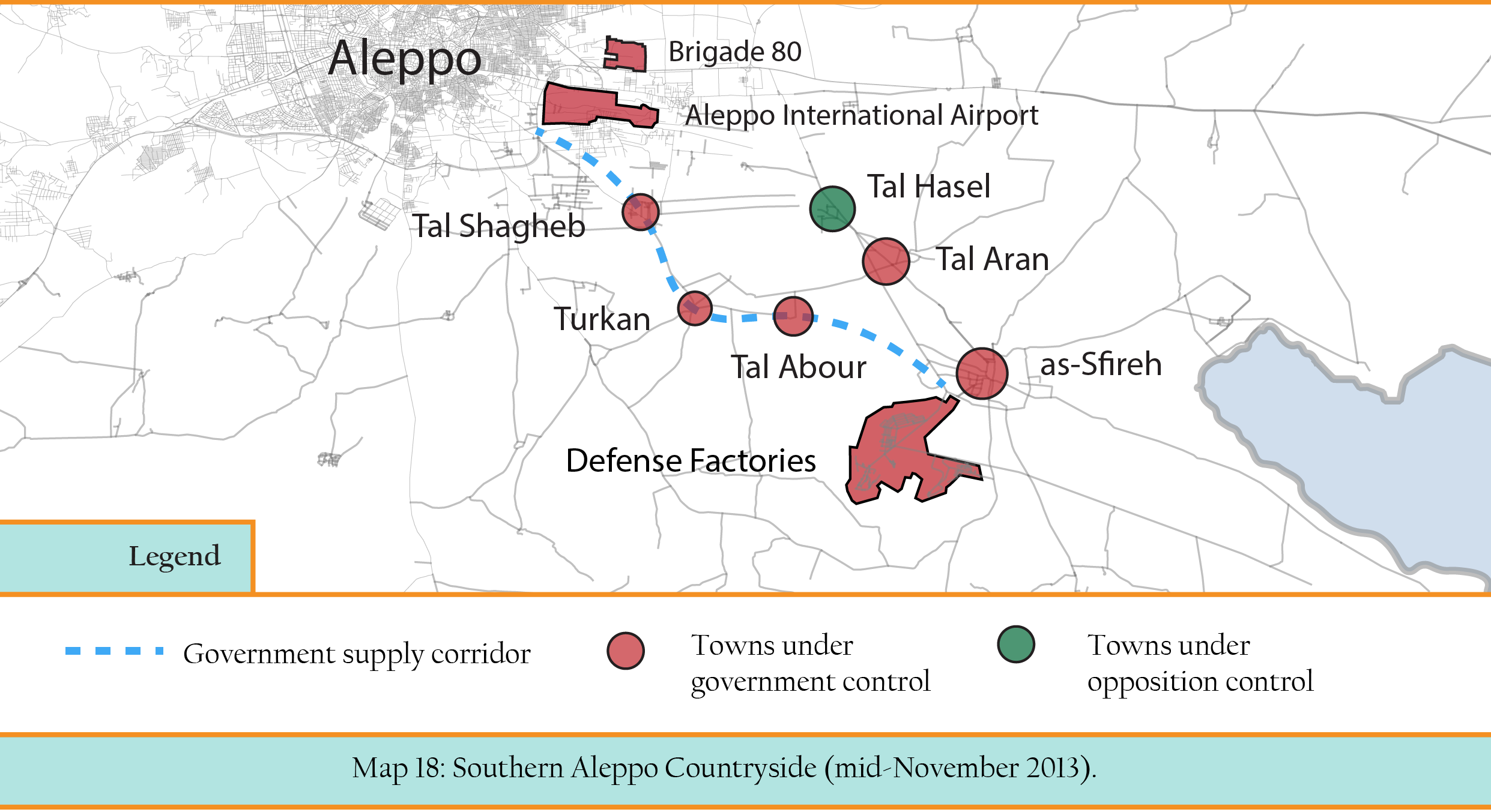 Source: compare with Institute for the Study of War Map p.27
Source: compare with Institute for the Study of War Map p.27
Even as it held off the government, the SMC found itself enmeshed in an internal crisis. Colonel Abduljabbar al-Oqaidi, the head of the Aleppo Military Council (AMC), released a video announcing his resignation and accusing the international community of conspiring against Syrians. He also criticized the political opposition of failing to represent Syrians and wasting time in meetings in expensive hotels.[61] On 18 November, Abdulqader Saleh, the charismatic head of the Liwa al-Tawhid, died in a regime airstrike.[62] Military setbacks had forced a realignment of the opposition with a number of key groups announcing that they had established the Islamic Front. Amidst this crisis, ISIS increased its control in Aleppo city. By December 2013, it controlled 12 districts in eastern Aleppo. (See Map 19)[63]
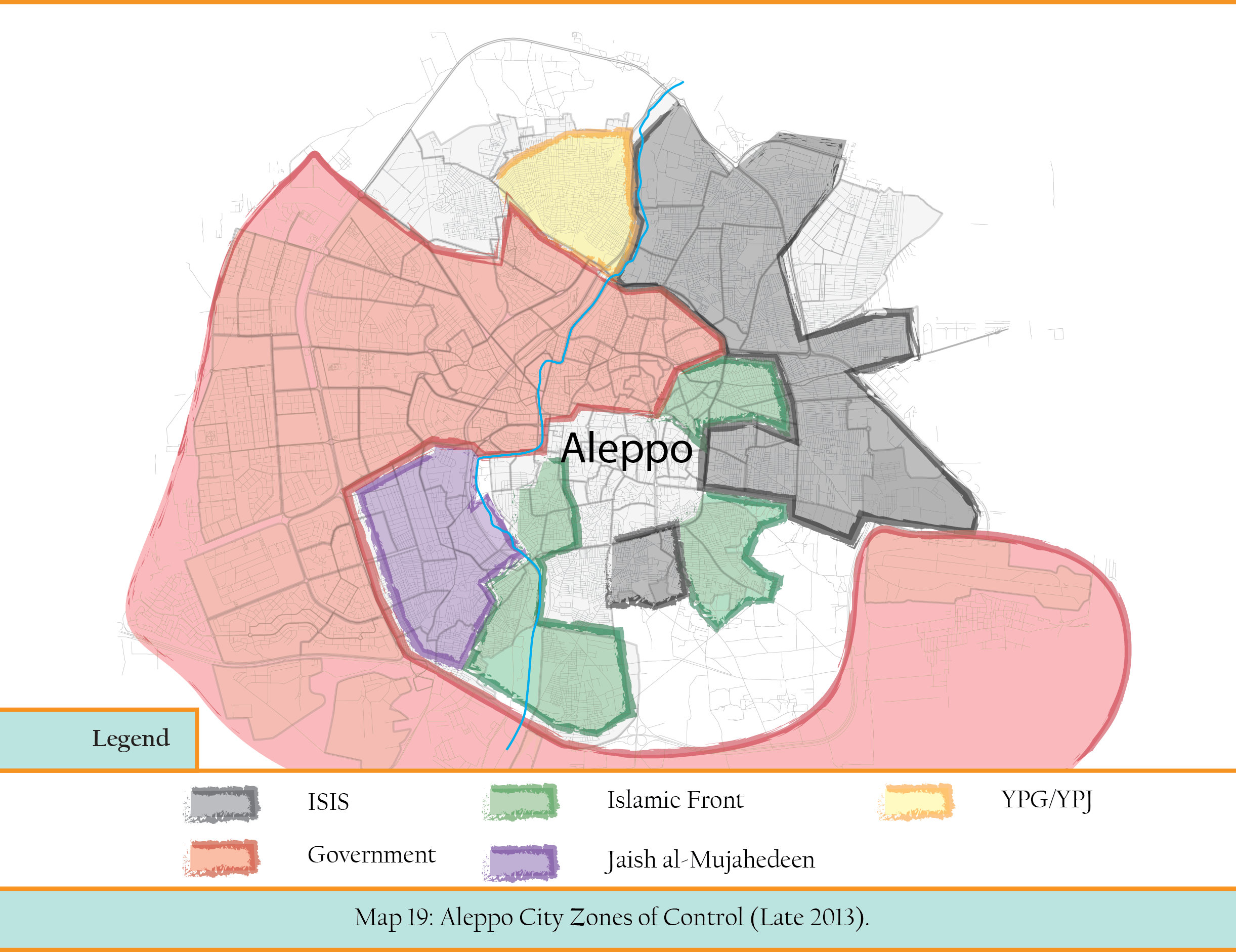 Source: Caerus p.33
Source: Caerus p.33
The Islamic Front included Jaish al-Islam, Suqour ash-Sham, Liwa al-Haqq and Liwa al-Tawhid. These groups had been part of the SMC, but had become critical of it and the western-backed National Coalition.[64] The Islamic Front emerged as the largest rebel coalition with between 45,000 and 70,000 armed men. The Islamic Front lacked religious coherence but most of the groups wanted some form of Islamist government.[65] The head of the Islamic Front’s Shoura council said the Front was working to provide a real alternative to the state in all aspects of life.[66]
In July 2012, the government withdrew from most Kurdish areas in northern Syria, handing control of administration and security to local Kurdish forces.[67] Kurdish parties, especially the Democratic Union Kurdistan (PYD) and its military wing the People’s Protection Units/Women’s Protection Unit (YPG/YPJ), took this opportunity to create an autonomous region.[68] In August 2012, Kurdish parties started discussions about an interim government.[69]
In November 2013, the YPG/YPJ launched an offensive in al-Hassakeh province and successfully took over 38 towns and military positions from ISIS.[70] After this victory, the PYD announced the establishment of an interim government to manage the Kurdish autonomous areas in three disconnected territories or cantons – Afrin, Kobani and al-Jazeera. (See Map 20) The National Coalition and others immediately criticized the move, saying this action benefitted the regime.[71]
In mid-December, government forces started a barrel bombing campaign of unprecedented intensity against opposition areas in Aleppo city, as well as on other opposition-held urban areas in the province.[72] It was clear that this tactic was not aimed at the armed opposition as it was often located too close to regime positions along front lines to be targeted, but was a way to devastate and depopulate rebel areas.
Box 5: Kurdish forces in Syria
Kurds are the largest ethno-linguistic minority in Syria. There are about two million Syrian Kurds, or eight-ten per cent of the pre-war population. They have long been deprived of basic linguistic and cultural rights, but managed despite this to develop a strong political organization in northern Syria, where they controlled large areas of fertile land. Even though many young Kurds participated in opposition protests against the Assad regime, traditional political forces took a mostly neutral stand.
There are two main Kurdish political wings. The strongest on the ground is the Democratic Union Kurdistan (PYD), established in 2003-2004. Its main competitor is the Kurdish National Council (KNC), which is a coalition of 16 small parties that was established as a result of the political vacuum in northern Syria in 2011.
In theory, PYD and KNC govern the Kurdish areas through the Supreme Kurdish Committee. In reality, they are political and ideological rivals and are allied with different regional Kurdish forces.[73] PYD is strongly associated with the Turkish PKK (Kurdish Worker’s Party) and both are part of the Union Kurdish Communities led by Abdullah Ocalan. KNC is supported by the Kurdish Regional Government (KRG) and was created to counterbalance the PYD’s growing influence over Kurdish issues in Syria.
These forces compete to represent Kurdish interests, not just in areas dominated by ethnic Kurds but also in major cities like Aleppo. Rojavayê Kurdistanê, or Rojava, meaning Western Kurdistan, is a self-governing region consisting of three geographically separate cantons: Afrin, Kobani and al-Jazeera.[74] In July 2012, the Syrian government significantly reduced its fighting forces in these areas.[75] PYD seized the opportunity and filled the political, administrative and security vacuum. In November 2013, the PYD officially announced the establishment of an administrative and government structure in these cantons. The autonomous region and its institutions include non-Kurdish elements such as Assyrians, Syriacs and Armenians, though the Kurdish component is clearly dominant.
Both political forces are backed by armed groups. However, the numbers and capacities are hugely different. In July 2012, Mesud Barazani, the president of the KRG, said that Iraqi Kurdistan was training Syrian Kurds to protect themselves during the conflict. In October 2012, about 1,200 fighters were trained, but have had problems operating in Syria due to the dominance of the PYD.[76]
The PYD run a local police force, called the Asayesh, which is responsible for law enforcement across Rojava. By the end of 2013, the Asayesh included between 20,000-25,000 members.[77]
The People’s Protection Units/Women’s Protection Units (YPG/YPJ) is the main military force of the PYD. Forty per cent of the fighters are women. In December 2013, the BBC estimated the YPG/YPJ to have between 10,000 and 15,000 fighters.[78] Credible estimates between 2014 and 2016 suggested the YPG/YPJ had between 30,000 and 40,000 members.[79]
Death Toll in 2013
[1] Opposition groups tend to create local operation rooms where the local leaders coordinate their offensive and defensive operations.
[1]BBC. “Syrians trade Khan al-Assal chemical weapons claims.” 19 March 2013. Accessed 5 March 2016. http://www.bbc.com/news/world-middle-east-21841217
[2]Thomson, Alex. “Syria chemical weapons: finger pointed at jihadists.” The Telegraph. 23 March 2013. Accessed 5 March 2016. http://www.telegraph.co.uk/news/worldnews/middleeast/syria/9950036/Syria-chemical-weapons-finger-pointed-at-jihadists.html
[3]Spillius, Alex and Damien McElroy. “Syria: ‘More than 80 killed’ in Aleppo University blasts.” The Telegraph. 15 Jan 2013. Accessed 5 March 2016. http://www.telegraph.co.uk/news/worldnews/middleeast/syria/9804032/Syria-More-than-80-killed-in-Aleppo-University-blasts.html
[4]“The civilian population of Aleppo, struggling for survival.” Focus on Syria Blog. 4 February 2013. Accessed 6 March 2016. http://www.focusonsyria.org/the-civilian-population-of-aleppo-struggling-for-survival/; Ferris, Elizabeth et al. “Syrian Crisis: Massive Displacement, Dire Needs and a Shortage of Solutions.” Brookings Institute. 18 September 2013. Accessed 3 March 2016. http://www.brookings.edu/~/media/research/files/reports/2013/09/18-syria-ferris-shaikh-kirisci/syrian-crisismassive-displacement-dire-needs-and-shortage-of-solutions-september-18-2013.pdf p.17.
[5]See: Regional Analysis Syria. 28 January 2013. Accessed 11 May 2016. http://www.mapaction.org/component/mapcat/download/2920.html?fmt=pdf p.11.
[6]Zarzar, Anas and Basel Dayoub. “Aleppo and Damascus Without Gas and Bread.” Al-Akhbar. 11 December 2012. Accessed 5 March 2016. http://english.al-akhbar.com/node/14337
[7]Aljazeera Arabic. “FSA controls as-Sfireh in Aleppo.” 1 April 2013. Accessed 5 March 2016. http://www.aljazeera.net/news/arabic/2013/4/1/%D8%A7%D9%84%D8%AD%D8%B1-%D9%8A%D8%B3%D9%8A%D8%B7%D8%B1-%D8%B9%D9%84%D9%89-%D8%A7%D9%84%D8%B3%D9%81%D9%8A%D8%B1%D8%A9-%D8%A8%D8%B1%D9%8A%D9%81-%D8%AD%D9%84%D8%A8
[8]Aljazeera Arabic. “Old Aleppo in the center of the conflict.” 15 April 2013. Accessed 5 March 2016. http://www.aljazeera.net/news/reportsandinterviews/2013/4/15/%D8%AD%D9%84%D8%A8-%D8%A7%D9%84%D9%82%D8%AF%D9%8A%D9%85%D8%A9-%D9%81%D9%8A-%D9%82%D9%84%D8%A8-%D8%A7%D9%84%D9%85%D8%B9%D8%B1%D9%83%D8%A9
[9]Spencer, Richard. “Al-Qaeda in Iraq claims merger with Syria’s Jabhat al-Nusra.” The Telegraph. 9 April 2013. Accessed 5 March 2016. http://www.telegraph.co.uk/news/worldnews/middleeast/syria/9982477/Al-Qaeda-in-Iraq-claims-merger-with-Syrias-Jabhat-al-Nusra.html
[10] Barber, Matthew. “Islamic State Declared in Syria.” Syria Comment. 14 April 2013. Accessed 5 March 2016. http://www.joshualandis.com/blog/al-qaida-and-jabhat-al-nusra-declare-islamic-state-in-syria/
[11]Ibrahim, Abdul Rahman al-Haj. “Salafism and the Salafis in Syria: from reform to Jihad.” Aljazeera Center for Studies. 26 May 2013. Accessed 5 March 2016. http://studies.aljazeera.net/reports/2013/05/2013520105748485639.htm; Mustafa, Hamza Mustafa. “Jabhet al-Nusra li-Ahl al-Sham: From its establishment to its division.” Arab Center for Research and Policy Studies. November 2013. Accessed 5 March 2016. http://www.dohainstitute.org/file/Get/738cac08-b4c5-4c85-9643-4da5e1443951.pdf ; See: https://www.youtube.com/watch?v=DIr1HoHJlQA
[12]The Telegraph. “Al-Qaeda probably responsible for Syrian suicide bombings, US spy chief claims.” 17 February 2012. http://www.telegraph.co.uk/news/worldnews/middleeast/syria/9087927/Al-Qaeda-probably-responsible-Syrian-suicide-bombings-US-spy-chief-claims.html
[13] U.S. Department of State. “Terrorist Designations of the al-Nusrah Front as an Alias for al-Qa’ida in Iraq.” 11 December 2012. Accessed 5 March 2016. http://www.state.gov/r/pa/prs/ps/2012/12/201759.htm
[14] Aljazeera English. “Iraq says al-Qaeda flowing into Syria.” 5 July 2012. Accessed 5 March 2016. http://www.aljazeera.com/news/middleeast/2012/07/201275185951213247.html
[15] See: https://www.youtube.com/watch?v=-hwQT43vFZA
[16]Mustafa, Hamza Mustafa. “Jabhet al-Nusra li-Ahl al-Sham: From its establishment to its division.” Arab Center for Research and Policy Studies. November 2013. Accessed 5 March 2016. http://www.dohainstitute.org/file/Get/738cac08-b4c5-4c85-9643-4da5e1443951.pdf p.21; NABA Agency. “ISIS’s rebellion against al-Qaeda.” 12 November 2013. Accessed 5 March 2016. http://www.naba.ps/arabic/?Action=Details&ID=24838
[17]Durfee, Liam et al. “The Battle for Aleppo.” Institute for the Study of War. 13 June 2013. Accessed 5 March 2016. http://www.understandingwar.org/backgrounder/battle-aleppo; Nassief, Isabel. “The Campaign for Homs and Aleppo.” Institute for the Study of War. January 2014. Accessed 5 March 2016. http://www.understandingwar.org/sites/default/files/Nassief-BattleforHomsAleppo-web.pdf pp. 21-23.
[18]Aljazeera Arabic. “Syrian rebels deny use of Sarin.” 6 May 2013. Accessed 5 March 2016. http://www.aljazeera.net/news/arabic/2013/5/6/%D8%AB%D9%88%D8%A7%D8%B1-%D8%B3%D9%88%D8%B1%D9%8A%D8%A7-%D9%8A%D9%86%D9%81%D9%88%D9%86-%D8%A7%D8%B3%D8%AA%D8%AE%D8%AF%D8%A7%D9%85-%D8%A7%D9%84%D8%B3%D8%A7%D8%B1%D9%8A%D9%86; Aljazeera English. “Syrian Rebels reject UN chemical weapon claim.” 6 May 2013. Accessed 5 March 2016. http://www.aljazeera.com/news/middleeast/2013/05/201356115118264895.html
[19]BBC. “UN chemical weapons inspectors to visit Syrian sites.” 31 July 2013. Accessed 5 March 2016. http://www.bbc.com/news/world-middle-east-23524536 ; Matthews, Bebeto. “U.N. inspectors confirm chemical attacks in Syria.” CBSNews. 12 December 2013. Accessed 5 March 2016. http://www.cbsnews.com/news/un-inspectors-confirm-chemical-attacks-in-syria/
[20]United Nations General Assembly. “Report of the independent international commission of inquiry on the Syrian Arab Republic.” A/HRC/25/65. 12 February 2014. p.73.
[21]Today’s Zaman. “Detained al-Nusra members say chemicals not for making sarin gas.” 13 September 2013. Accessed 5 March 2016. http://www.todayszaman.com/national_detained-al-nusra-members-say-chemicals-not-for-making-sarin-gas_326332.html
[22]France24. “Rebels could resort to chemical weapons, Syria warns.” 8 December 2012. Accessed 5 March 2016. http://www.france24.com/en/20121208-syria-warns-rebels-may-resort-chemical-weapons-assad-united-nations-islamists
[23]The Jerusalem Post. “Observatory: Syrian war death toll rises to 82,000.” 12 May 2013. Accessed 5 March 2016. http://www.jpost.com/Syria-Crisis/Syrian-war-death-toll-rises-to-82000-opposition-group-312932
[24]Violations Documentation Center in Syria. “Latest Martyrs.” 30 May 2013. Accessed 11 May 2016. http://www.vdc-sy.info/index.php/en/martyrs/1/c29ydGJ5PWEua2lsbGVkX2RhdGV8c29ydGRpcj1ERVNDfGFwcHJvdmVkPXZpc2libGV8ZXh0cmFkaXNwbGF5PTB8cHJvdmluY2U9NnxzdGFydERhdGU9MjAxMS0wMy0wMXxlbmREYXRlPTIwMTMtMDUtMzB8; Violations Documentation Center in Syria. “Latest Regime Fatalities.” 30 May 2013. Accessed 11 May 2016. http://www.vdc-sy.info/index.php/en/otherstatistics/1/c29ydGJ5PWEua2lsbGVkX2RhdGV8c29ydGRpcj1ERVNDfGFwcHJvdmVkPXZpc2libGV8ZXh0cmFkaXNwbGF5PTB8cHJvdmluY2U9NnxzdGFydERhdGU9MjAxMS0wMy0wMXxlbmREYXRlPTIwMTMtMDUtMzB8
[25]See: https://www.youtube.com/watch?v=rktmEhEp7Zk
[26]Looney, Chris. “The Northern Storm Brigade: Its History, Current Status, and Why It Matters.” Syria Comment. 18 March 2014. Accessed 5 March 2016. http://www.joshualandis.com/blog/northern-storm-brigade-history-current-status-matters-chris-looney/
[27]See: https://www.youtube.com/watch?v=rktmEhEp7Zk; Looney, Chris. “The Northern Storm Brigade: Its History, Current Status, and Why It Matters.” Syria Comment. 18 March 2014. Accessed 5 March 2016. http://www.joshualandis.com/blog/northern-storm-brigade-history-current-status-matters-chris-looney/
[28]Aljazeera English. “Syrian rebels claim control of western Aleppo.” 24 July 2013. Accessed 5 March 2016. http://www.aljazeera.com/news/middleeast/2013/07/201372412628810967.html
[29]The Guardian. “Syrian rebels face UN investigation over Aleppo footage.” 3 August 2013. Accessed 5 March 2016. http://www.theguardian.com/world/2013/aug/03/syrian-rebels-un-aleppo-footage
[30]Nassief, Isabel. “The Campaign for Homs and Aleppo.” Institute for the Study of War. January 2014. Accessed 20 March 2016. http://www.understandingwar.org/sites/default/files/Nassief-BattleforHomsAleppo-web.pdf p.26.
[31]Dark, Edward. “Aleppo Starves Under Siege.” Al-Monitor. 15 July 2013. Accessed 20 March 2016. http://www.al-monitor.com/pulse/originals/2013/07/aleppo-syria-rebel-siege-assad.html#
[32]See: https://www.youtube.com/watch?v=RuZCr9Z9AAQ; Scott, Lucas. “The Siege of Aleppo.” EA Worldview. 26 July 2013. Accessed 20 March 2016. http://eaworldview.com/2013/07/syria-feature-the-siege-of-aleppo/
[33]Dark, Edward. “Aleppo Starves Under Siege.” Al-Monitor. 15 July 2013. Accessed 20 March 2016. http://www.al-monitor.com/pulse/originals/2013/07/aleppo-syria-rebel-siege-assad.html#
[34]Author’s interview with Aleppo resident. December 2015.
[35]Nassief, Isabel. “The Campaign for Homs and Aleppo.” Institute for the Study of War. January 2014. Accessed 5 March 2016. http://www.understandingwar.org/sites/default/files/Nassief-BattleforHomsAleppo-web.pdf p.32.
[36]Nassief, Isabel. “The Campaign for Homs and Aleppo.” Institute for the Study of War. January 2014. Accessed 5 March 2016. http://www.understandingwar.org/sites/default/files/Nassief-BattleforHomsAleppo-web.pdf p.32.
[37]Aljazeera Arabic. “Aleppo: heated frontlines and desire for life.” 7 October 2013. Accessed 5 March 2016. http://www.aljazeera.net/news/reportsandinterviews/2013/10/7/%D9%81%D9%8A-%D8%AD%D9%84%D8%A8-%D8%AC%D8%A8%D9%87%D8%A7%D8%AA-%D9%85%D8%B4%D8%AA%D8%B9%D9%84%D8%A9-%D9%88%D8%A5%D8%B5%D8%B1%D8%A7%D8%B1-%D8%B9%D9%84%D9%89-%D8%A7%D9%84%D8%AD%D9%8A%D8%A7%D8%A9; See: https://www.youtube.com/watch?v=L5C3nXqvmEk
[38]See: https://www.youtube.com/watch?v=fu9FdgeB2KU
[39]See: https://www.youtube.com/watch?v=fN6HUZES3l8 ; AlArabiya. “FSA withdraws from al-Sfireh.” 1 November 2013. Accessed 5 March 2016. http://www.alarabiya.net/ar/arab-and-world/syria/2013/11/01/%D8%A7%D9%84%D8%AC%D9%8A%D8%B4-%D8%A7%D9%84%D8%AD%D8%B1-%D9%8A%D9%86%D8%B3%D8%AD%D8%A8-%D9%85%D9%86-%D8%A8%D9%84%D8%AF%D8%A9-%D8%A7%D9%84%D8%B3%D9%81%D9%8A%D8%B1%D8%A9-%D9%81%D9%8A-%D8%B1%D9%8A%D9%81-%D8%AD%D9%84%D8%A8-%D8%B9%D9%82%D8%A8-%D9%85%D9%88%D8%A7%D8%AC%D9%87%D8%A7%D8%AA.html
[40]Nassief, Isabel. “The Campaign for Homs and Aleppo.” Institute for the Study of War. January 2014. Accessed 5 March 2016. http://www.understandingwar.org/sites/default/files/Nassief-BattleforHomsAleppo-web.pdf p.33.
[41]AlArabiya. “Protests in Idlib and Aleppo Countryside against ISIS.” 11 July 2013. Accessed 5 March 2016. http://www.alarabiya.net/ar/arab-and-world/syria/2013/07/11/%D8%A7%D8%B4%D8%AA%D8%A8%D8%A7%D9%83%D8%A7%D8%AA-%D8%B9%D9%86%D9%8A%D9%81%D8%A9-%D8%A8%D9%8A%D9%86-%D8%A7%D9%84%D8%AC%D9%8A%D8%B4-%D8%A7%D9%84%D8%AD%D8%B1-%D9%88-%D9%85%D8%B3%D9%84%D8%AD%D9%88-%D8%AF%D9%88%D9%84-%D8%A7%D9%84%D8%B9%D8%B1%D8%A7%D9%82-%D9%88%D8%A7%D9%84%D8%B4%D8%A7%D9%85-%D8%A7%D9%84%D8%A5%D8%B3%D9%84%D8%A7%D9%85%D9%8A%D8%A9.html; See: https://www.youtube.com/watch?v=8aYEgcG6ATk
[42]Szybala, Valerie. “Al-Qaeda Shows its True Colors in Syria.” Institute for the Study of War. 1 August 2013. Accessed 5 March 2016. http://www.understandingwar.org/backgrounder/al-qaeda-shows-its-true-colors-syria; BBC. “Key Free Syria Army rebel ‘killed by Islamist group’.” 12 July 2013. Accessed 5 March 2016. http://www.bbc.com/news/world-middle-east-23283079
[43]Szybala, Valerie. “Al-Qaeda Shows its True Colors in Syria.” Institute for the Study of War. 1 August 2013. Accessed 5 March 2016. http://www.understandingwar.org/backgrounder/al-qaeda-shows-its-true-colors-syria
[44]Khaddour, Khder. “The Struggle for Syria’s Regions.” Middle East Research and Information Project. Vol. 43. Issue. 4. Accessed 5 March 2016. http://www.merip.org/mer/mer269/struggle-syrias-regions
[45]Russia Today. “FSA confirms al-Qaeda’s intentions of establishing an Islamic State in north Syria by the end of Ramadan.” 16 July 2013. Accessed 5 March 2016. https://arabic.rt.com/news/621329-_%D8%A7%D9%84%D8%AC%D9%8A%D8%B4_%D8%A7%D9%84%D8%AD%D8%B1_%D9%8A%D8%A4%D9%83%D8%AF_%D8%B3%D8%B9%D9%8A_%D8%A7%D9%84%D9%82%D8%A7%D8%B9%D8%AF%D8%A9_%D9%84%D8%AA%D8%B4%D9%83%D9%8A%D9%84_%D8%AF%D9%88%D9%84%D8%A9_%D8%A7%D8%B3%D9%84%D8%A7%D9%85%D9%8A%D8%A9_%D8%B4%D9%85%D8%A7%D9%84_%D8%B3%D9%88%D8%B1%D9%8A%D8%A9_%D9%86%D9%87%D8%A7%D9%8A%D8%A9_%D8%B1%D9%85%D8%B6%D8%A7%D9%86/; Smith, Hanna Lucinda. “The Backlash Begins.” Asharq al-Awsat. 30 August 2013. Accessed 5 March 2016. http://english.aawsat.com/2013/08/article55315304/the-backlash-begins; Szybala, Valerie. “Al-Qaeda Shows its True Colors in Syria.” Institute for the Study of War. 1 August 2013. Accessed 5 March 2016. http://www.understandingwar.org/backgrounder/al-qaeda-shows-its-true-colors-syria; BBC. “Key Free Syria Army rebel ‘killed by Islamist group’.” 12 July 2013. Accessed 5 March 2016.
[46]Billo, Mohamed Ikbal. “ISIS kidnaps 9 from Ahrar Syria Brigade.” 12 September 2013. Accessed 5 March 2016. http://www.orient-news.net/ar/news_show/5282
[47]Al-Quds al-Arabi. “ISIS launches a military campaign against FSA in Aleppo countryside.” 12 September 2013. Accessed 5 March 2016. http://www.alquds.co.uk/?p=83741
[48]Al-Akhbar. “Al-Qaeda affiliate overruns rebel-held Azaz in northern Syria.” 18 September 2013. http://english.al-akhbar.com/node/17065; Idiz, Semih. “Turkey’s Syria Nightmare Goes From Bad to Worse.” Al-Monitor. 20 September 2013. Accessed 5 March 2016. http://www.al-monitor.com/pulse/originals/2013/09/al-qaeda-syria-turkey-nightmare-border.html#
[49]See: ISIS statement. 14 October 2013. Accessed 11 May 2016. http://halabnews.net/?p=39767
[50]Caerus. “Mapping the Conflict in Aleppo, Syria.” February 2014. Accessed 5 March 2016. http://caerusassociates.com/wp-content/uploads/2014/02/Caerus_AleppoMappingProject_FinalReport_02-18-14.pdf p.32.
[51]See: ISIS statement. 14 October 2013. Accessed 11 May 2016. http://halabnews.net/?p=39767
[52]“Joint Rapid Assessment of North Aleppo.” March 2013. Accessed 5 March 2016. http://www.acu-sy.co/en/wp-content/uploads/2015/03/Aleppo-Assessment-Report.pdf p.5.
[53]“Joint Rapid Assessment of North Aleppo.” March 2013. Accessed 5 March 2016. http://www.acu-sy.co/en/wp-content/uploads/2015/03/Aleppo-Assessment-Report.pdf p.7.
[54]UNITAR. “Four Years of Human Suffering.” 2014. Accessed 5 March 2016. http://unosat.web.cern.ch/unosat/unitar/downloads/SyriaFourYearsOfHumanSuffering/UNITAR-UNOSAT_SyriaFourYearsOfHumanSuffering.pdf p.32.
[55]See: https://www.youtube.com/watch?v=5lDvXpeihYI
[56]See: https://www.youtube.com/watch?v=1VZkRs6G62E
[57]See: https://www.youtube.com/watch?v=1VZkRs6G62E; Nassief, Isabel. “The Campaign for Homs and Aleppo.” Institute for the Study of War. January 2014. Accessed 5 March 2016. http://www.understandingwar.org/sites/default/files/Nassief-BattleforHomsAleppo-web.pdf
[58]See: http://www.documents.sy/image.php?id=2548&lang=ar
[59]BBC. “Syria rebels urge Aleppo mobilisation to halt assault.” 13 November 2013. Accessed 5 March 2016. http://www.bbc.com/news/world-middle-east-24927097
[60]Nassief, Isabel. “The Campaign for Homs and Aleppo.” Institute for the Study of War. January 2014. Accessed 5 March 2016. http://www.understandingwar.org/sites/default/files/Nassief-BattleforHomsAleppo-web.pdf
[60]See: Rebel Statement. 11 November 2013. Accessed 11 May 2016. http://www.documents.sy/image.php?id=2548&lang=ar p.35.
[61]See: https://www.youtube.com/watch?v=2IIeWTOC1Zg
[62]BBC. “Top Syrian rebel commander Abdul Qadir al-Saleh dies.” 18 November 2013. Accessed 5 March 2016. http://www.bbc.com/news/world-middle-east-24984365 ; Spencer, Richard. “Syrian rebel leader killed in Assad air strike.” 18 November 2013. Accessed 5 March 2016. http://www.telegraph.co.uk/news/worldnews/middleeast/syria/10456707/Syrian-rebel-leader-killed-in-Assad-air-strike.html
[63]Caerus. “Mapping the Conflict in Aleppo, Syria.” February 2014. Accessed 5 March 2016. http://caerusassociates.com/wp-content/uploads/2014/02/Caerus_AleppoMappingProject_FinalReport_02-18-14.pdf p.32.
[64]Lund, Aron. “The Politics of the Islamic Front, Part 2: An Umbrella Organization.” Carnegie Endowment for International Peace. 15 January 2014. Accessed 5 March 2016. http://carnegieendowment.org/syriaincrisis/?fa=54204
[65]Lund, Aron. “The Politics of the Islamic Front, Part 1: Structure and Support.” Carnegie Endowment for International Peace. 14 January 2014. Accessed 5 March 2016. http://carnegieendowment.org/syriaincrisis/?fa=54183; Szybala, Valerie. “A Power Move by Syria’s Rebel Forces.” Institute for the Study of War Blog. 22 November 2013. Accessed 5 March 2016. http://iswresearch.blogspot.hu/2013/11/a-power-move-by-syria-rebel-forces.html
[66]See: https://www.youtube.com/watch?v=03n9wfTGU70
[67]Gutman, Roy. “Assad hands control of Syria’s Kurdish areas to PKK, sparking outrage in Turkey.” McClatchy DC. 26 July 2012. Accessed 5 March 2016. http://www.mcclatchydc.com/news/nation-world/world/article24733318.html
[68]Arango, Tim. “Kurds Prepare to Pursue More Autonomy in a Fallen Syria.” The New York Times. 28 September 2012. Accessed 5 March 2016. http://www.nytimes.com/2012/09/29/world/middleeast/kurds-to-pursue-more-autonomy-in-a-fallen-syria.html?_r=0
[69]Asharq al-Awsat. “Syria: parties discuss forming Kurdish regional government.” 13 August 2013. Accessed 5 March 2016. http://english.aawsat.com/2013/08/article55313396/syria-parties-discuss-forming-kurdish-regional-government
[70]Bernstein, Eric. “The Serekeniye Martyr’s Offensive: Kurds Consolidate Control in Hasaka.” Institute for the Study of War Blog. 21 November 2013. Accessed 5 March 2016. http://iswsyria.blogspot.hu/2013/11/the-serekeniye-martyrs-offensive-ypg.html
[71]eKurd. “Syria’s Kurds: In or Out?” 17 November 2013. Accessed 5 March 2016. http://ekurd.net/mismas/articles/misc2013/11/syriakurd948.htm
[72]Nassief, Isabel. “The Campaign for Homs and Aleppo.” Institute for the Study of War. January 2014. Accessed 5 March 2016. pp. 35-36.
[73]International Crisis Group. “Flight of Icarus? The PYD’s Precarious Rise in Syria.”8 May 2014. Accessed 5 March 2016. http://www.crisisgroup.org/~/media/Files/Middle%20East%20North%20Africa/Iraq%20Syria%20Lebanon/Syria/151-flight-of-icarus-the-pyd-s-precarious-rise-in-syria.pdf pp. 11-12.
[74]International Crisis Group. “Flight of Icarus? The PYD’s Precarious Rise in Syria.”8 May 2014. Accessed 5 March 2016. http://www.crisisgroup.org/~/media/Files/Middle%20East%20North%20Africa/Iraq%20Syria%20Lebanon/Syria/151-flight-of-icarus-the-pyd-s-precarious-rise-in-syria.pdf pp. 12-15.
[75]Tezkan, Mehmet. “Kurds Take Control As Regime Retreats From Northern Syria.” Al-Monitor. 1 July 2012. Accessed 5 March 2016. http://www.al-monitor.com/pulse/tr/security/01/07/and-now-here-is-northern-syria.html#
[76]International Crisis Group. “Syria’s Kurds: A Struggle Within a Struggle.” 22 January 2013. Accessed 5 March 2016. http://www.crisisgroup.org/~/media/Files/Middle%20East%20North%20Africa/Iraq%20Syria%20Lebanon/Syria/136-syrias-kurds-a-struggle-within-a-struggle.pdf p.5.
[77]International Crisis Group. “Flight of Icarus? The PYD’s Precarious Rise in Syria.”8 May 2014. Accessed 5 March 2016. http://www.crisisgroup.org/~/media/Files/Middle%20East%20North%20Africa/Iraq%20Syria%20Lebanon/Syria/151-flight-of-icarus-the-pyd-s-precarious-rise-in-syria.pdf p.14.
[78]BBC. “Guide to the Syrian rebels.” 13 December 2013. Accessed 5 March 2016. http://www.bbc.com/news/world-middle-east-24403003
[79]The Daily Star. “Kurdish militia has 35,000 fighters: spokesman.” 27 December 2013. Accessed 5 March 2016. http://www.dailystar.com.lb/News/Middle-East/2013/Dec-27/242372-kurdish-militia-has-35000-fighters-spokesman.ashx#axzz2oNa3sbT8; Blanche, Ed. “Syria: The looming battle of the Azaz corridor.” The Arab Weekly. 15 January 2016. http://www.thearabweekly.com/?id=3346
 The Aleppo Project
The Aleppo Project